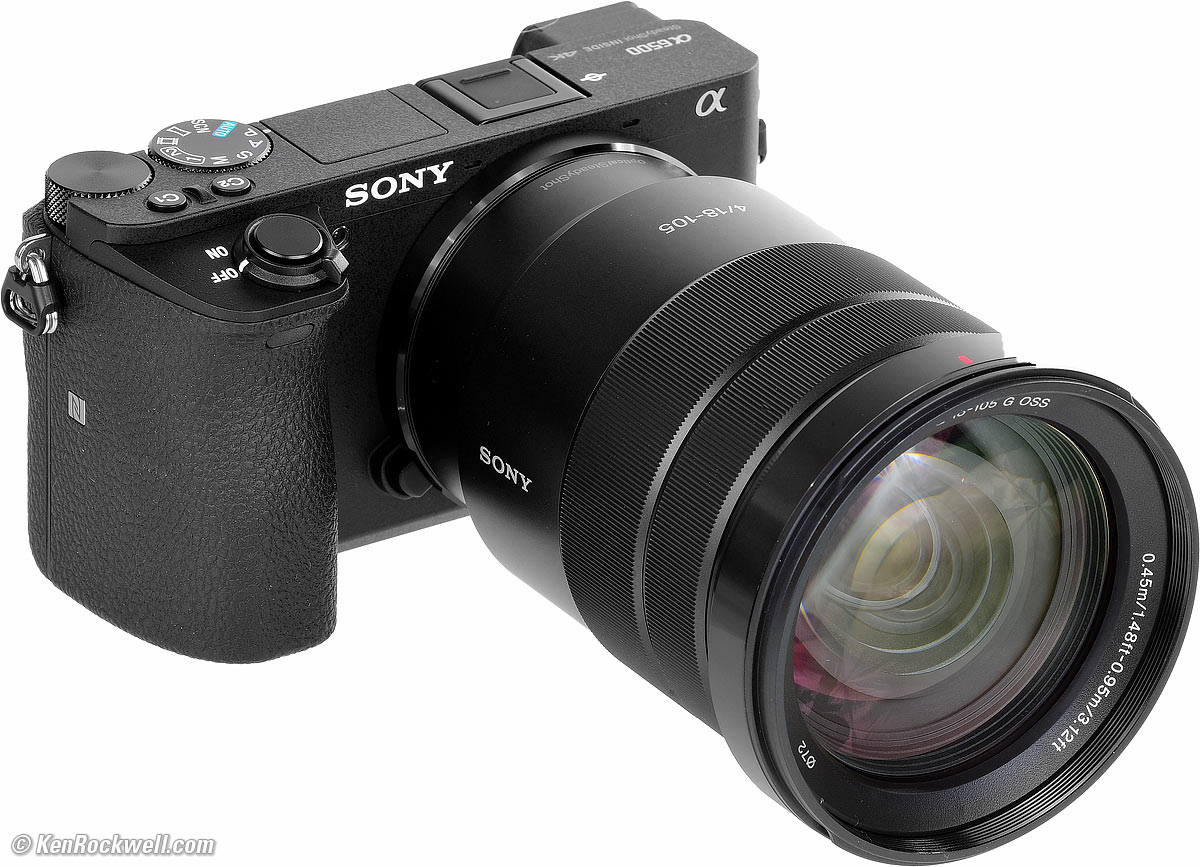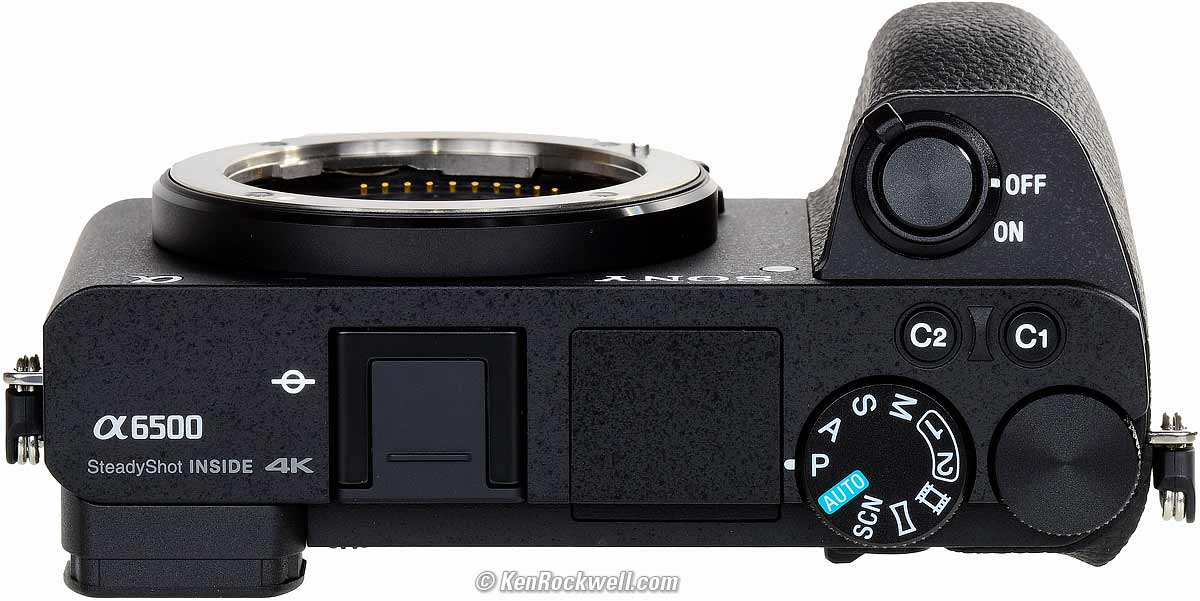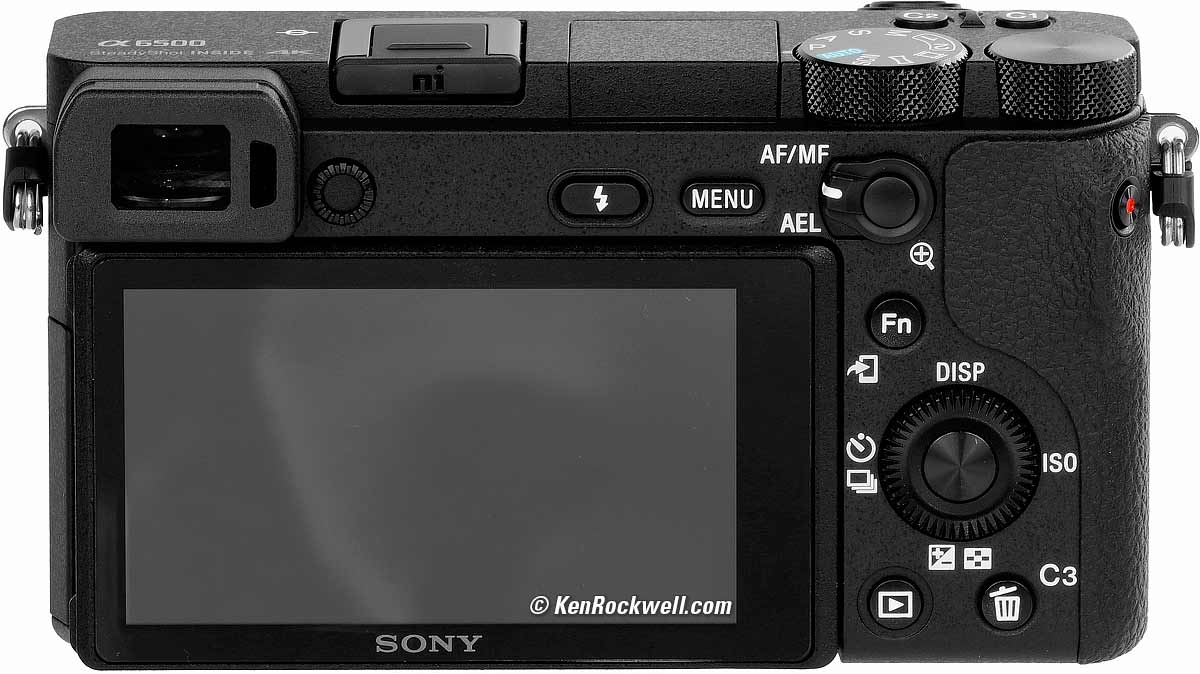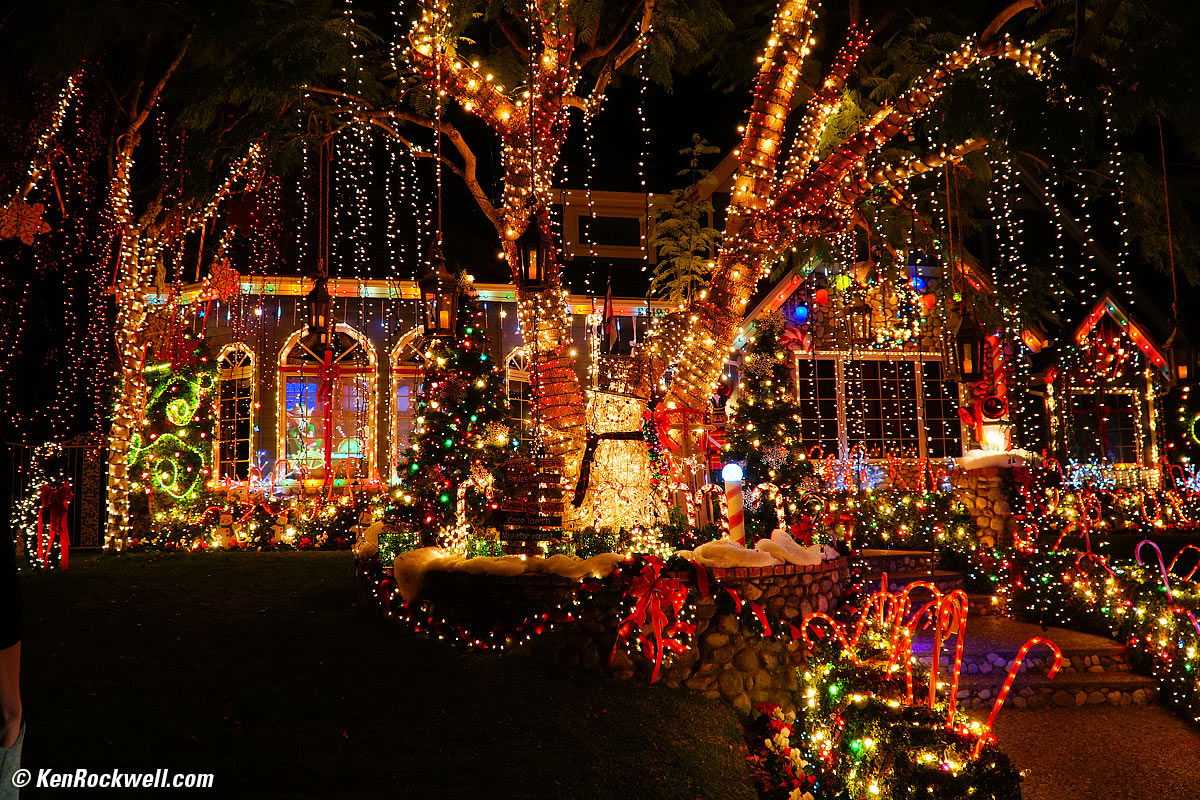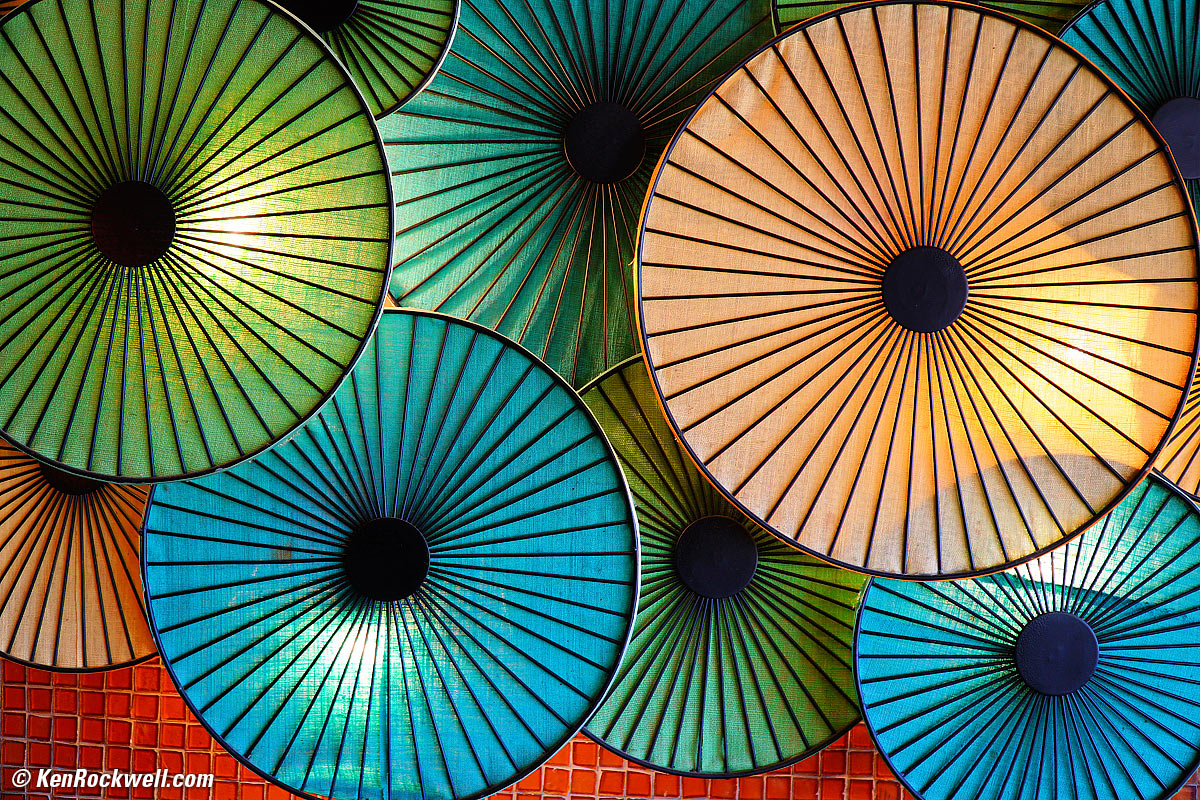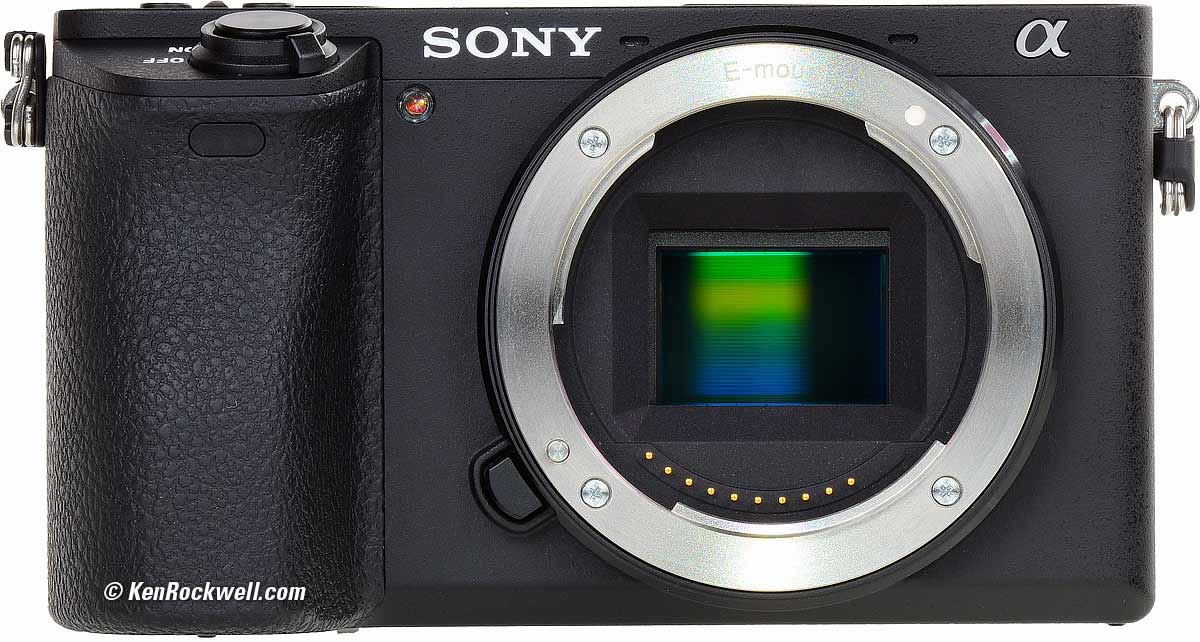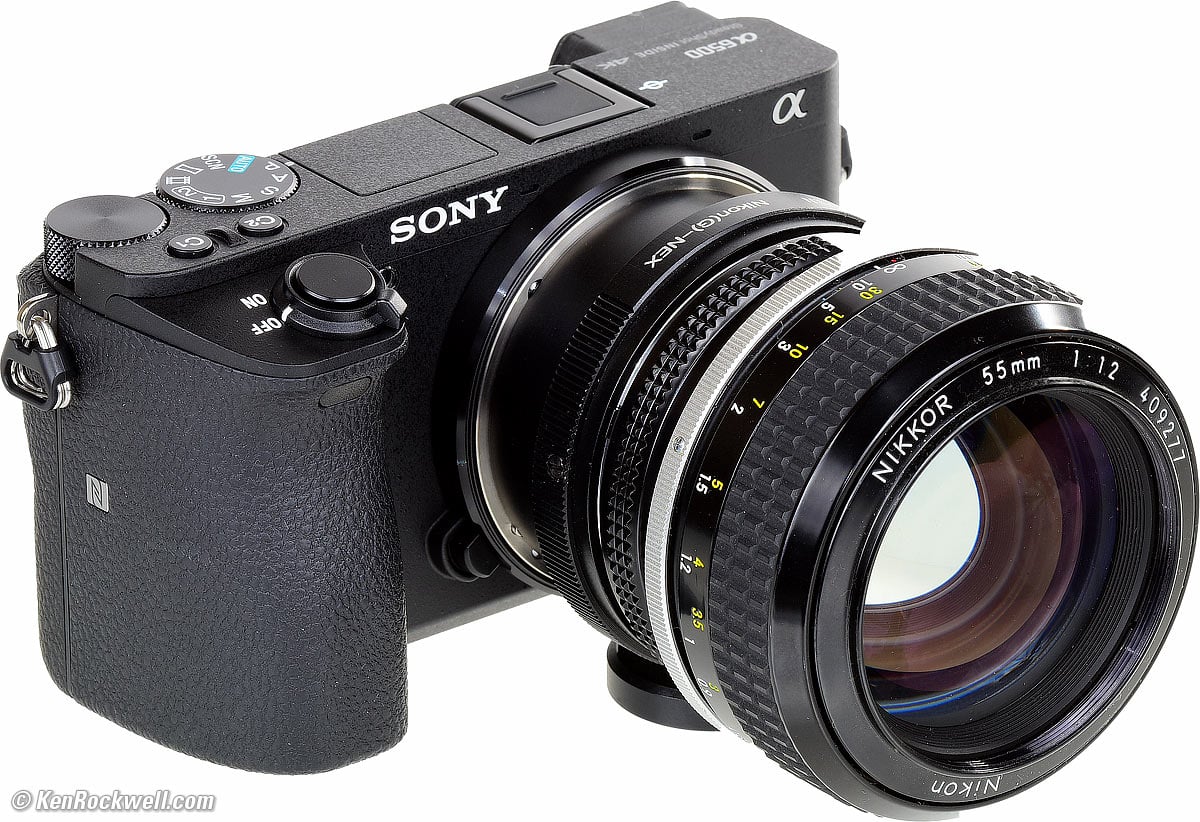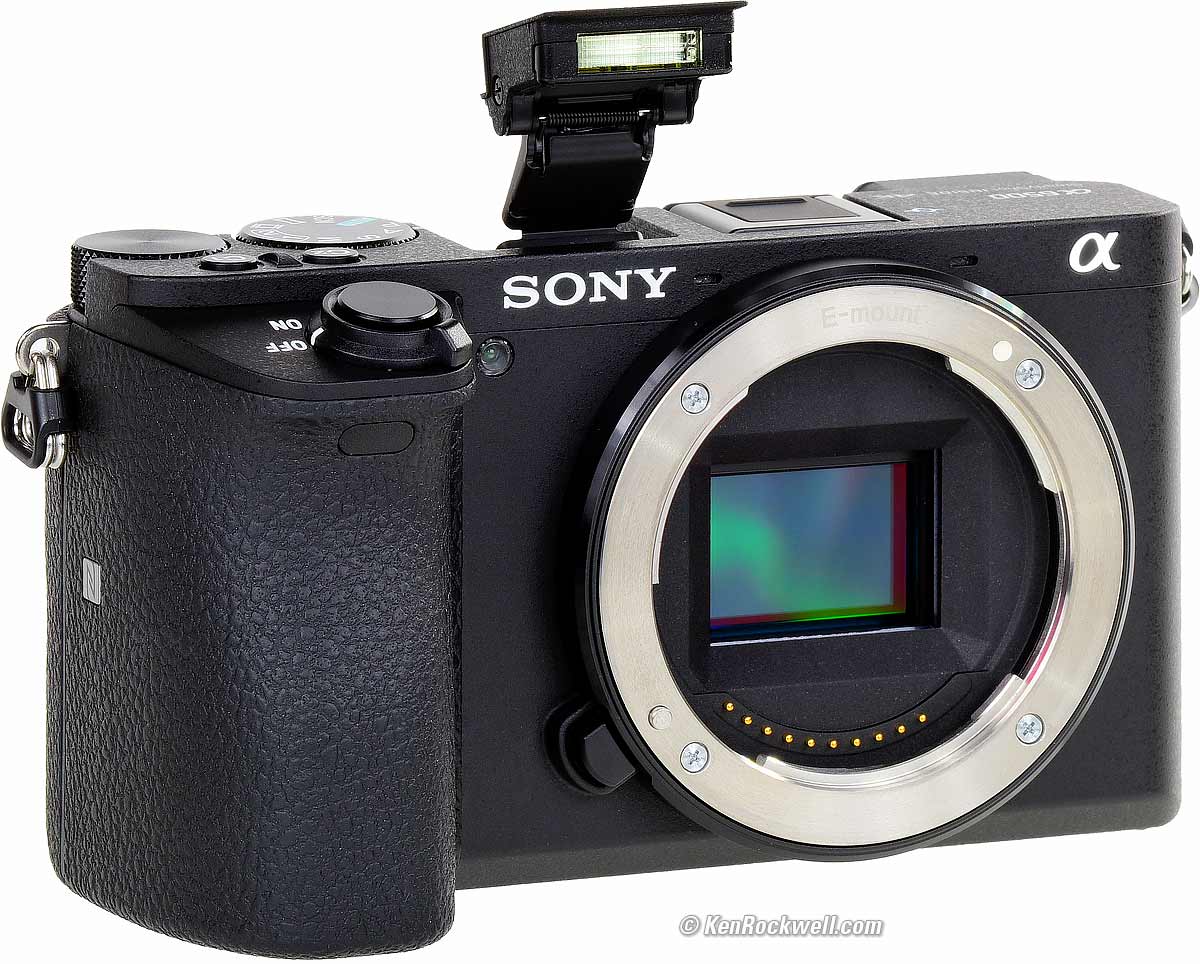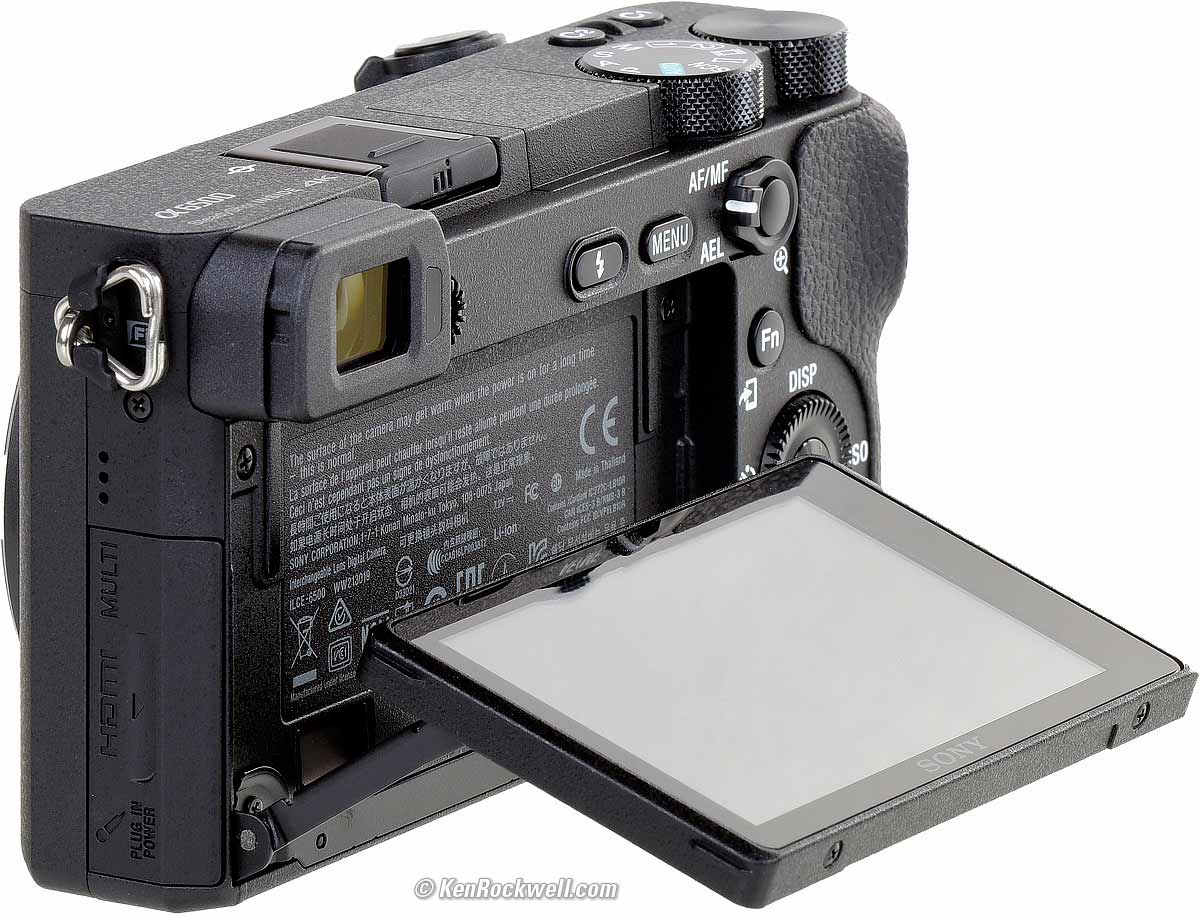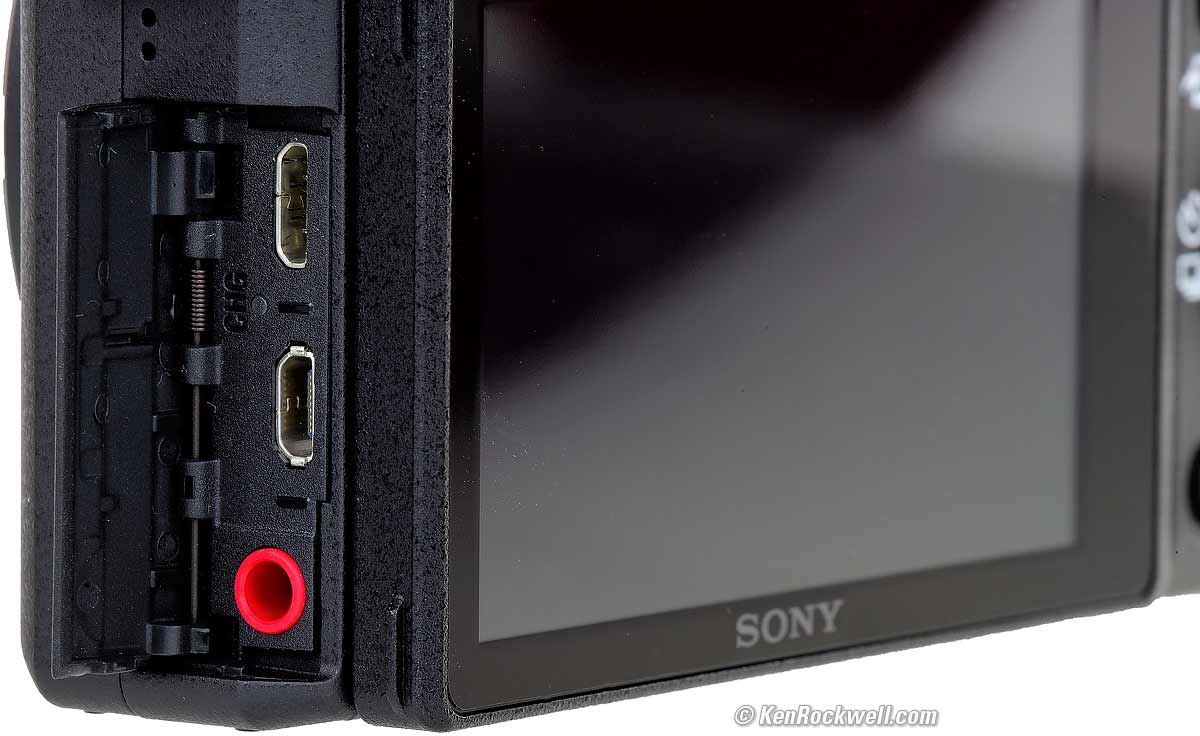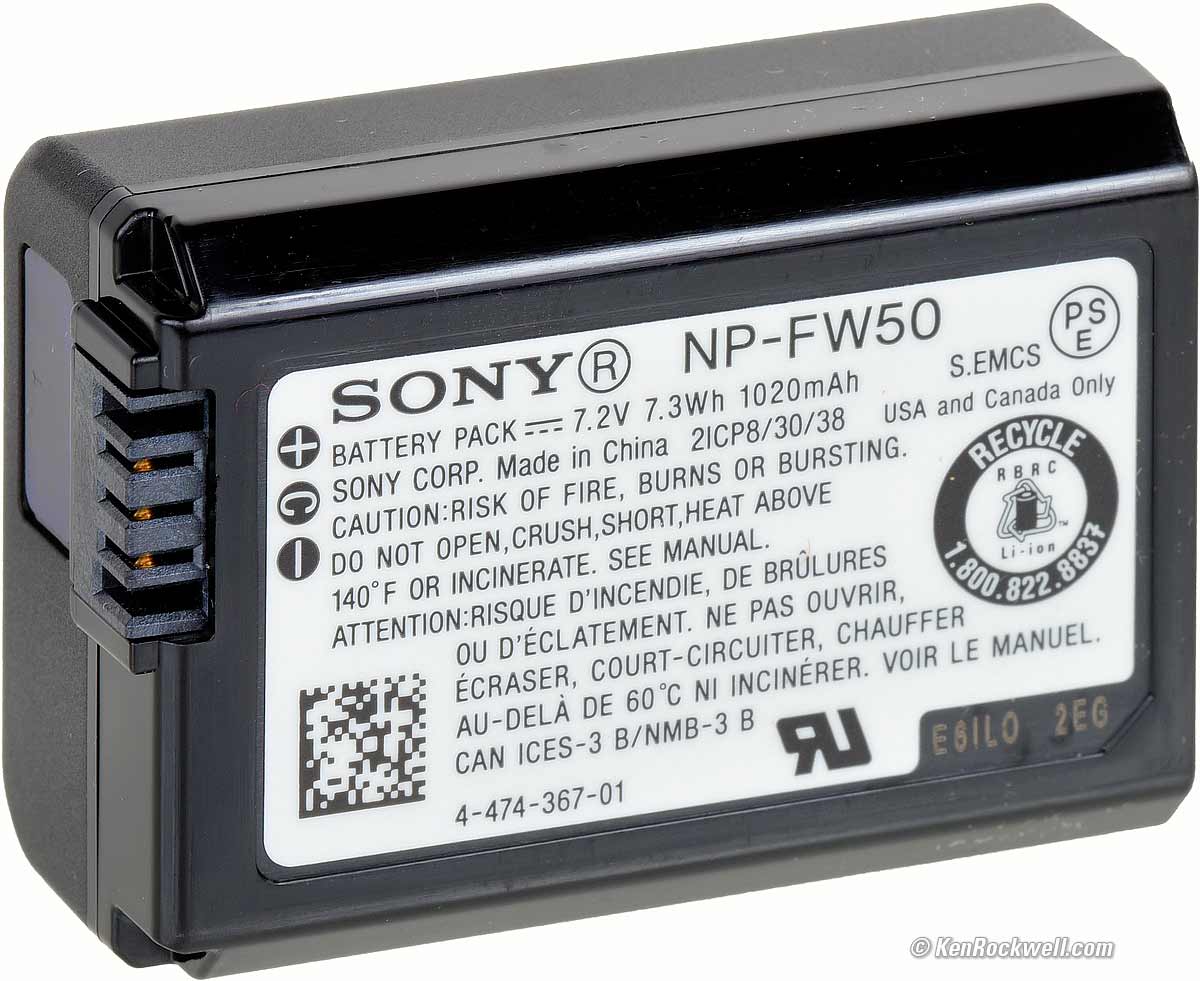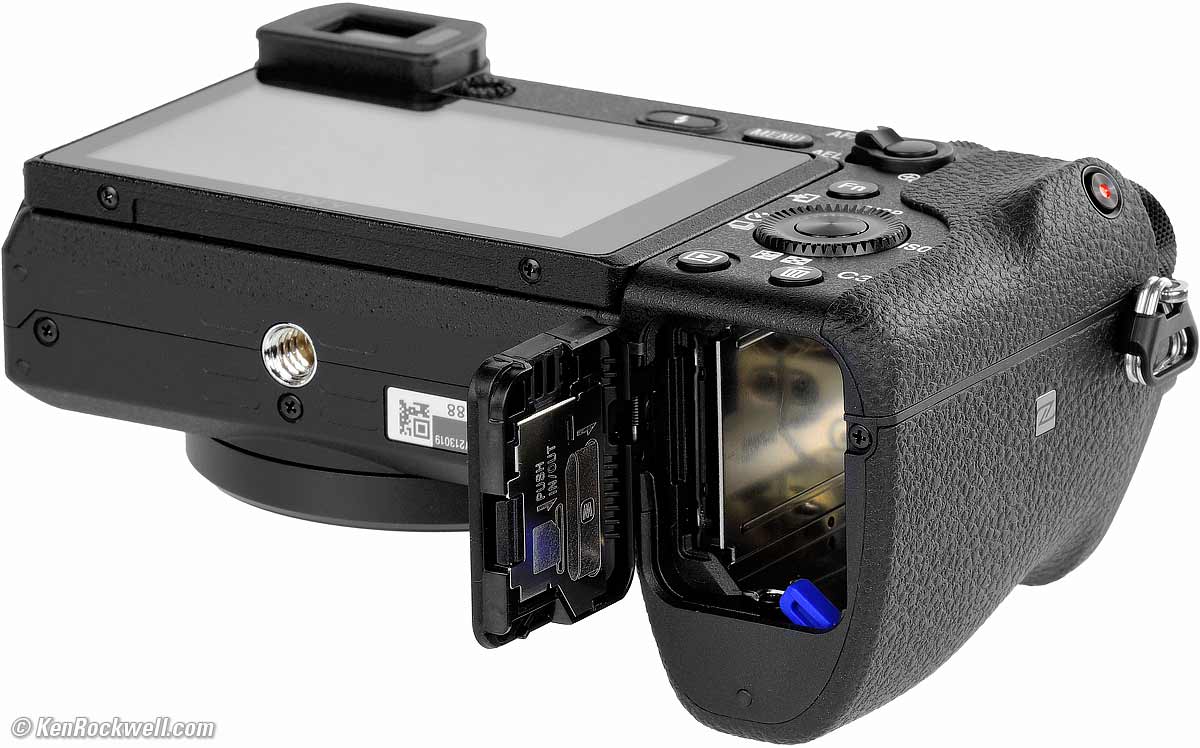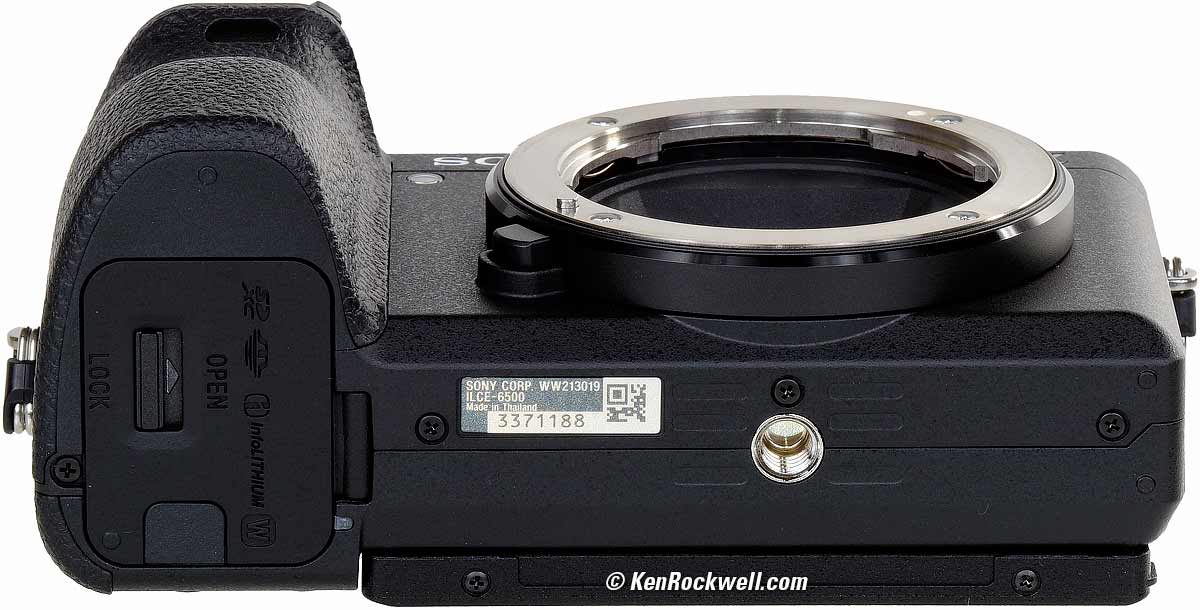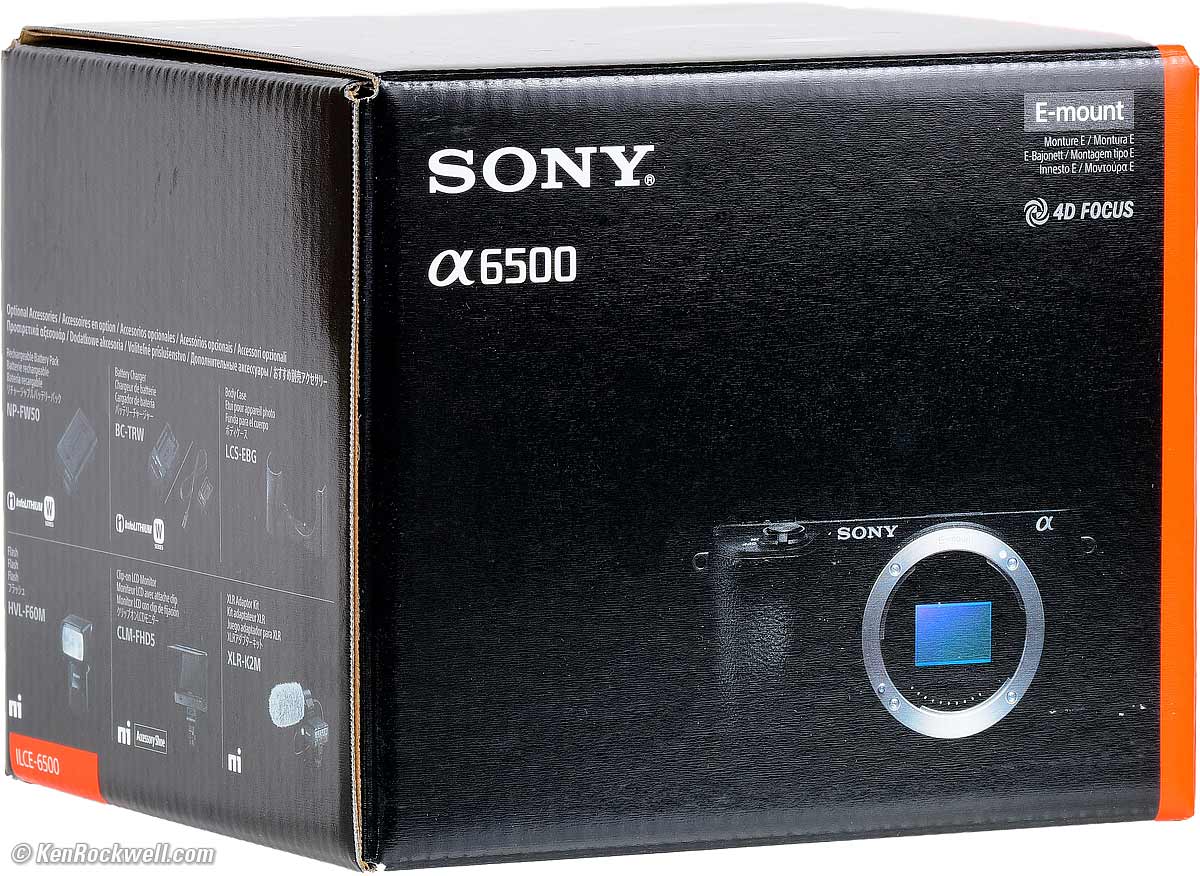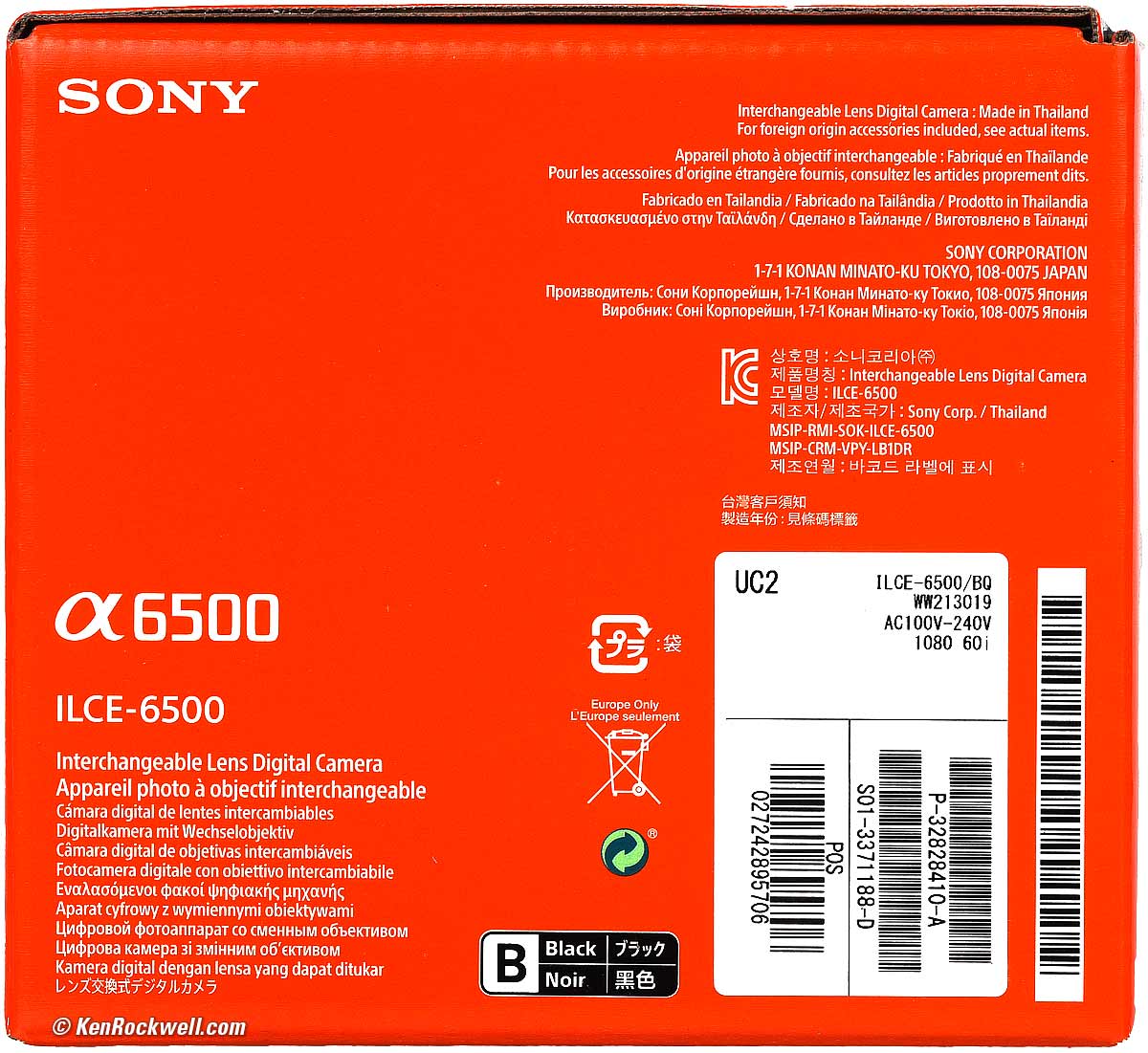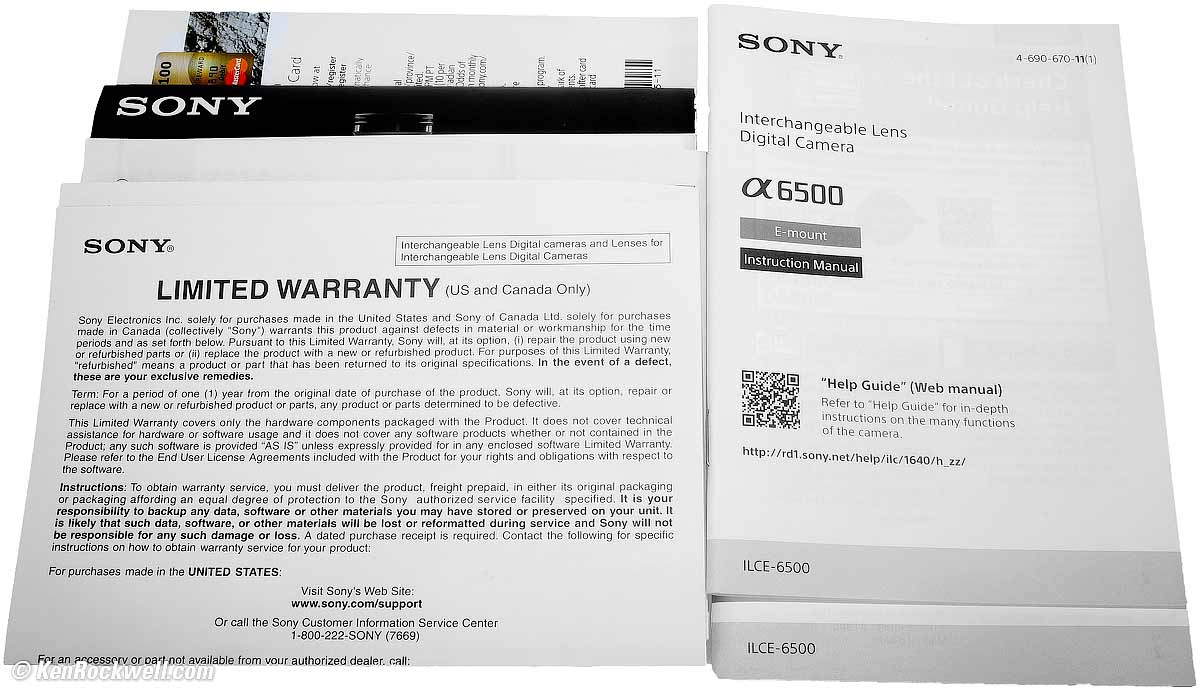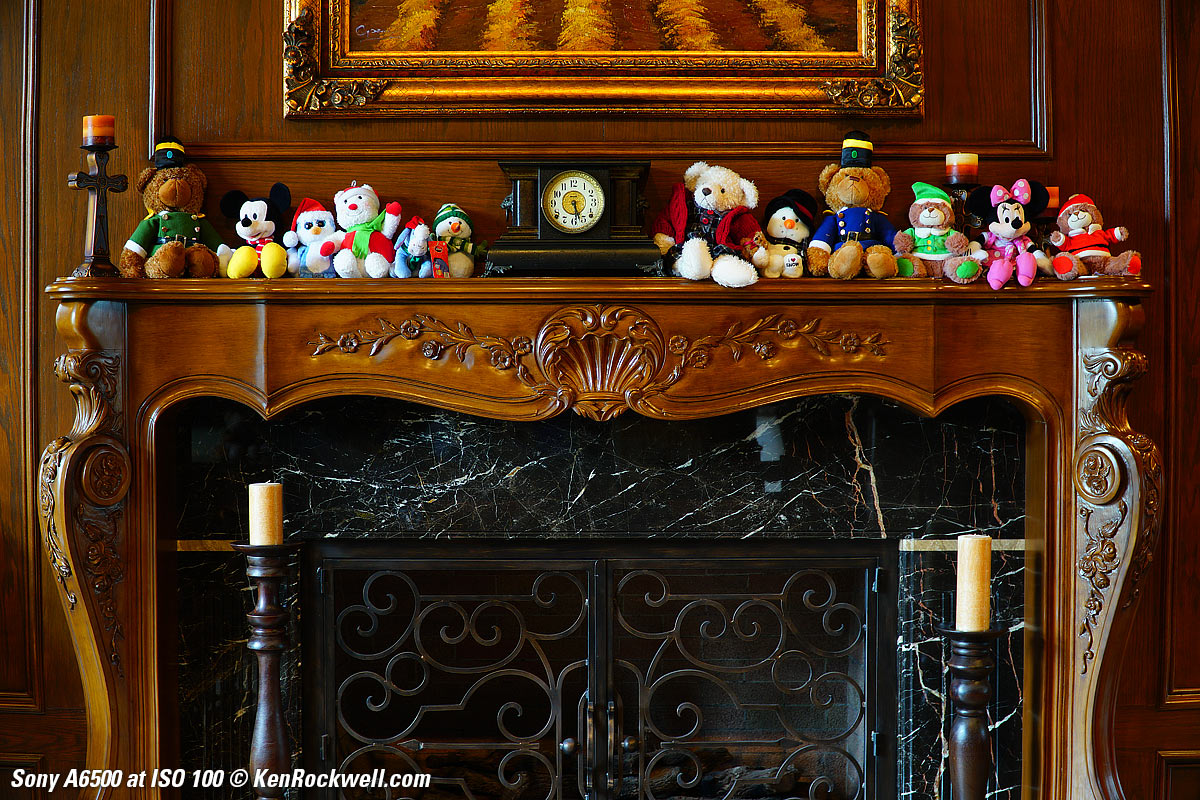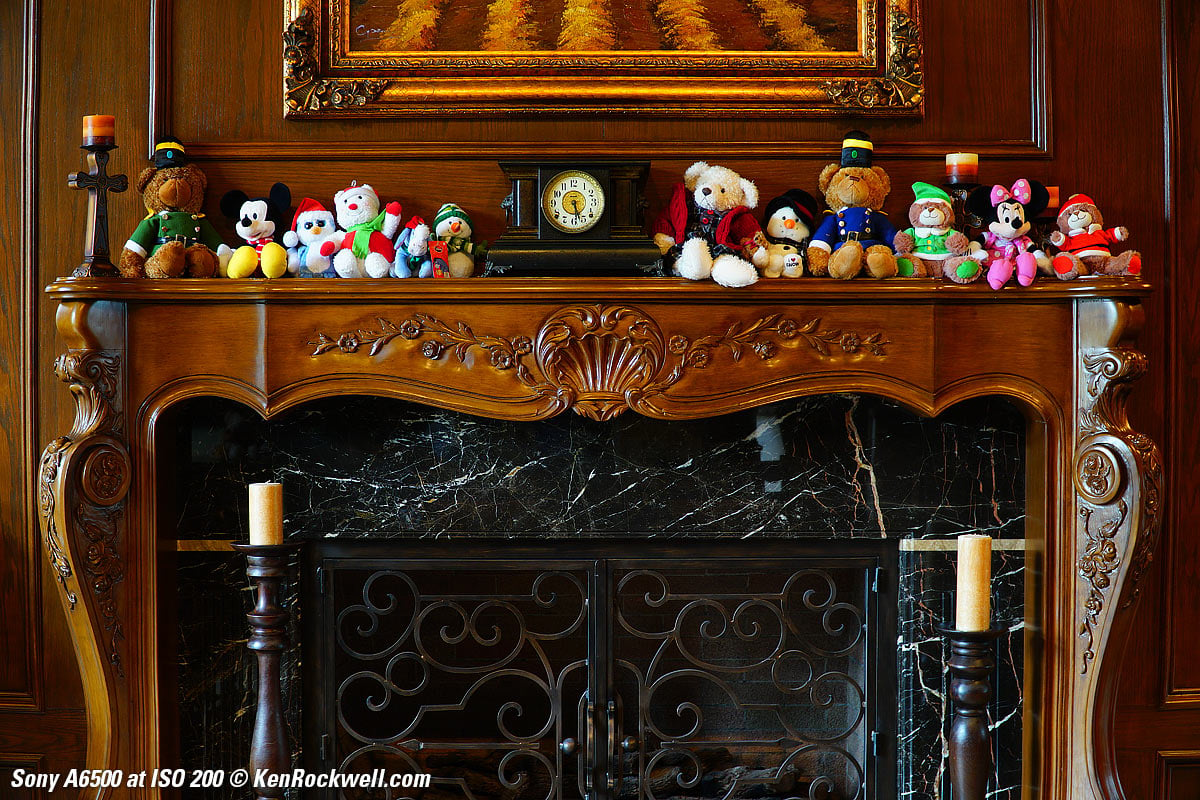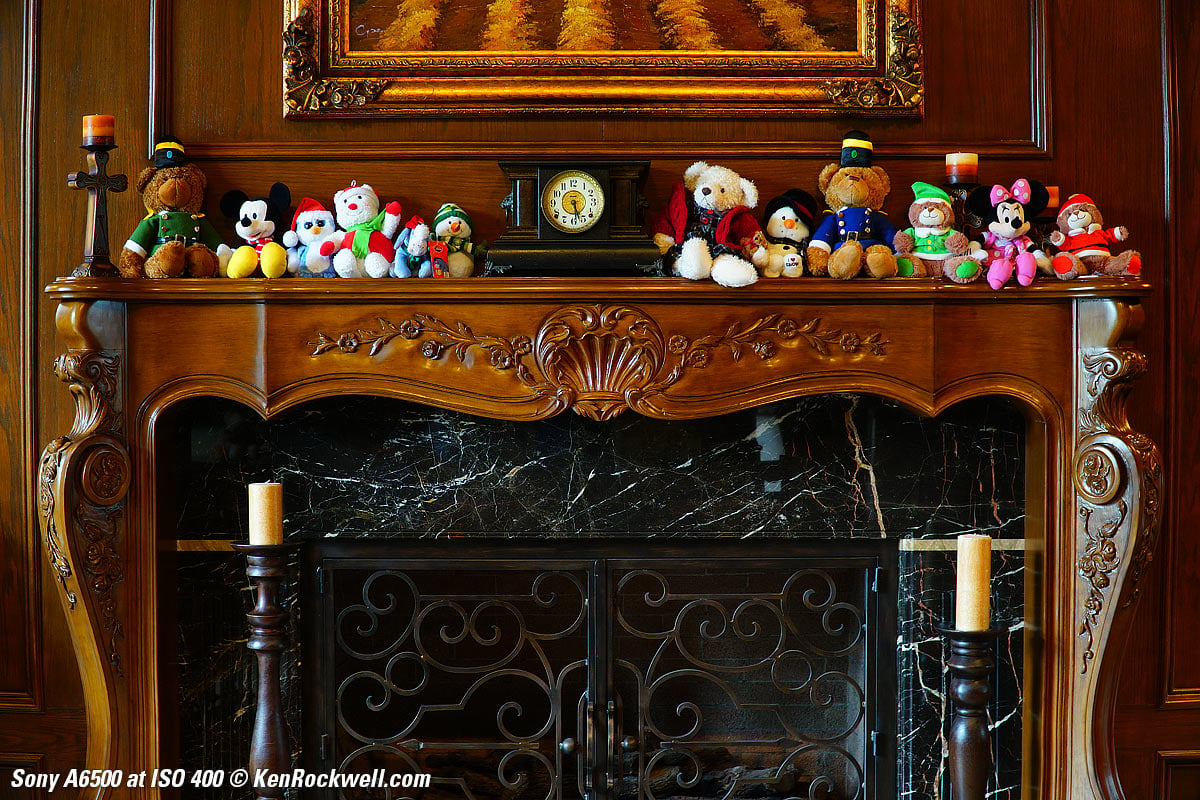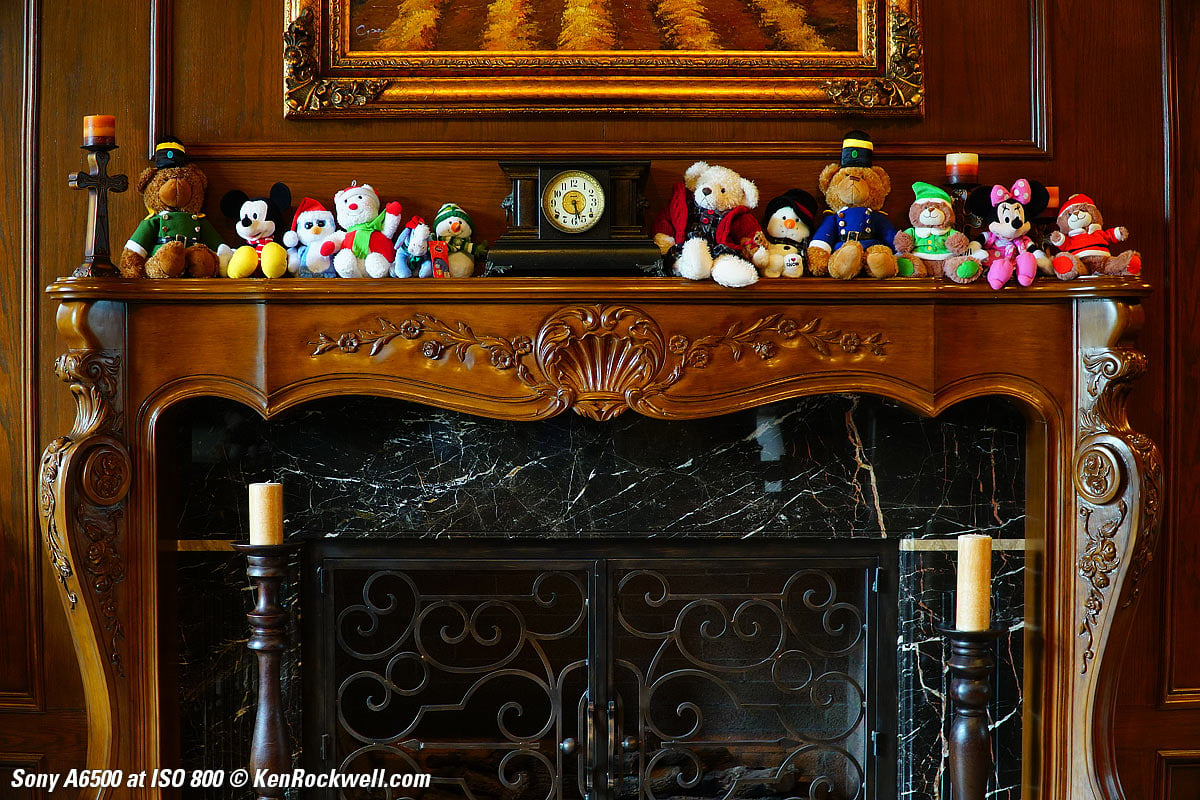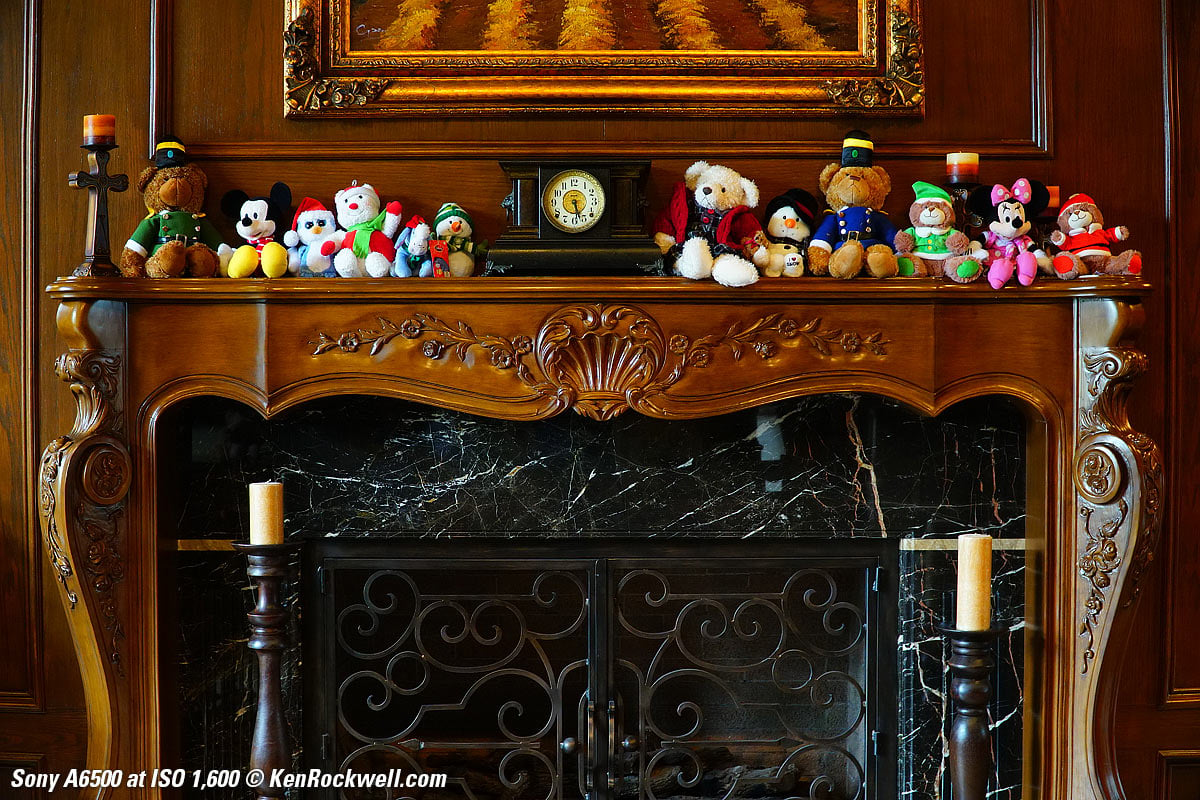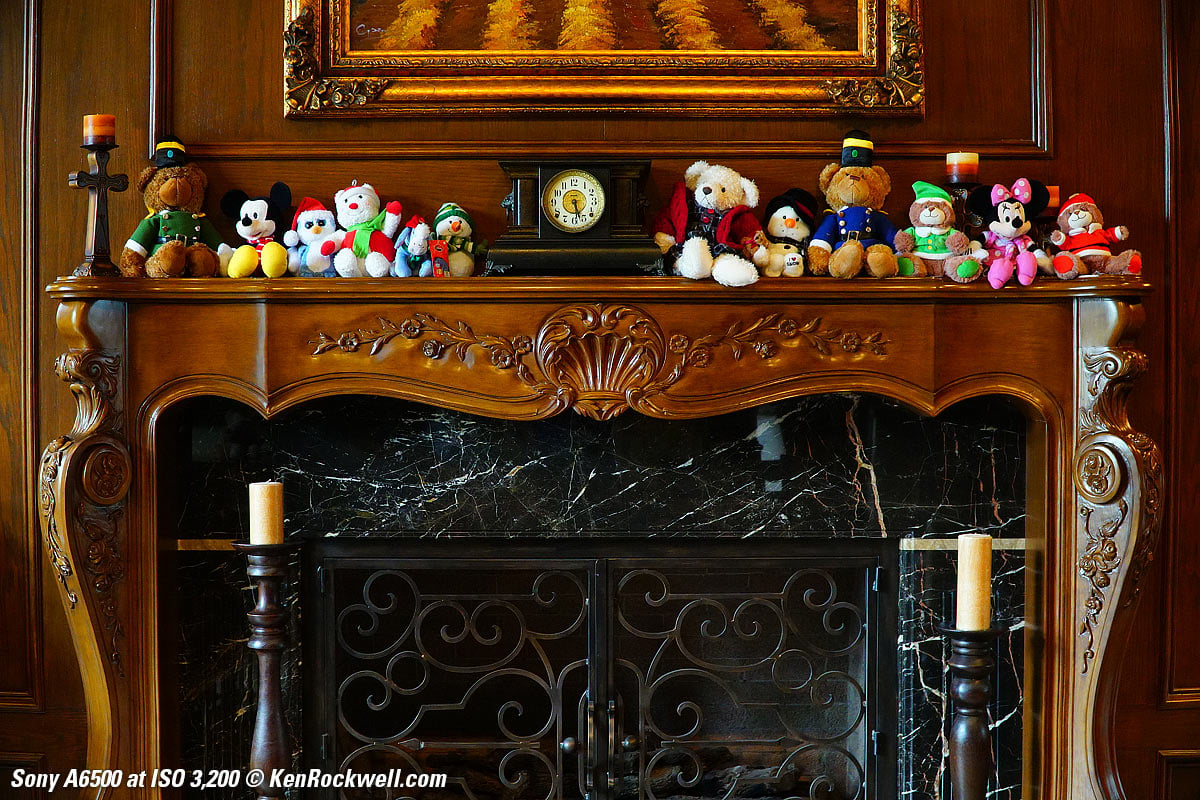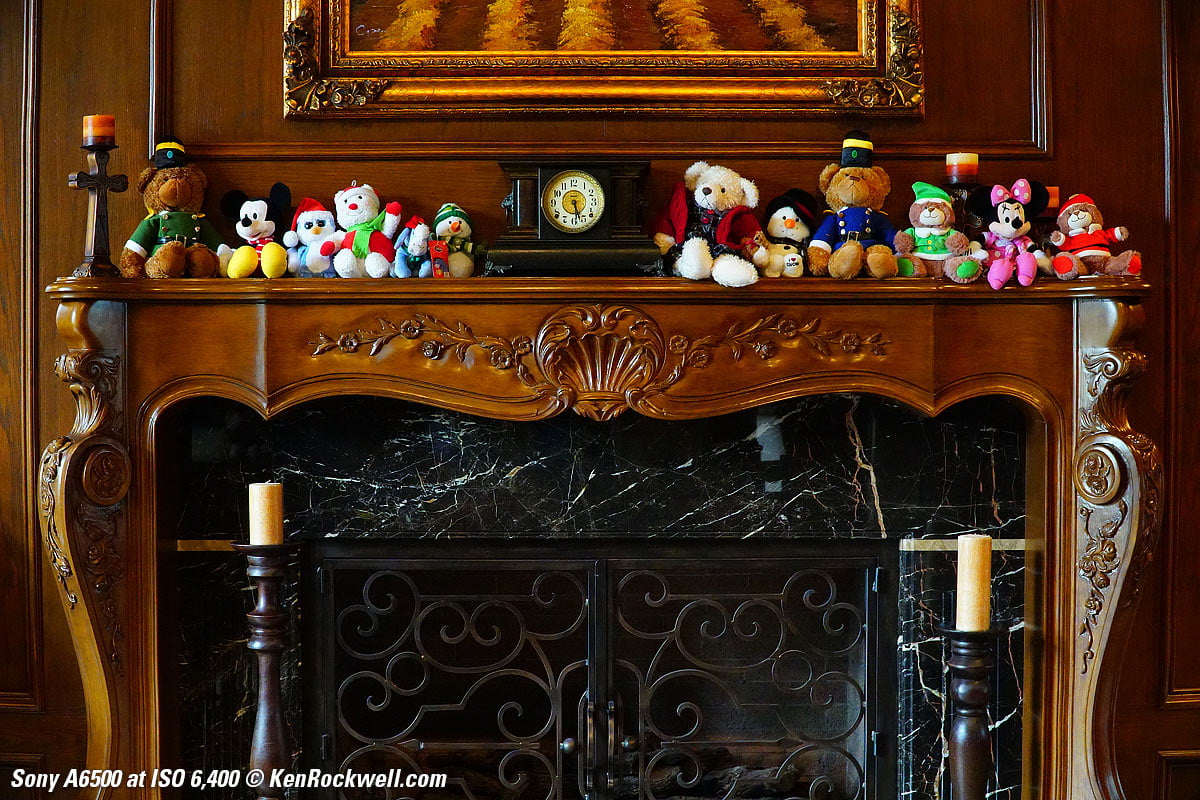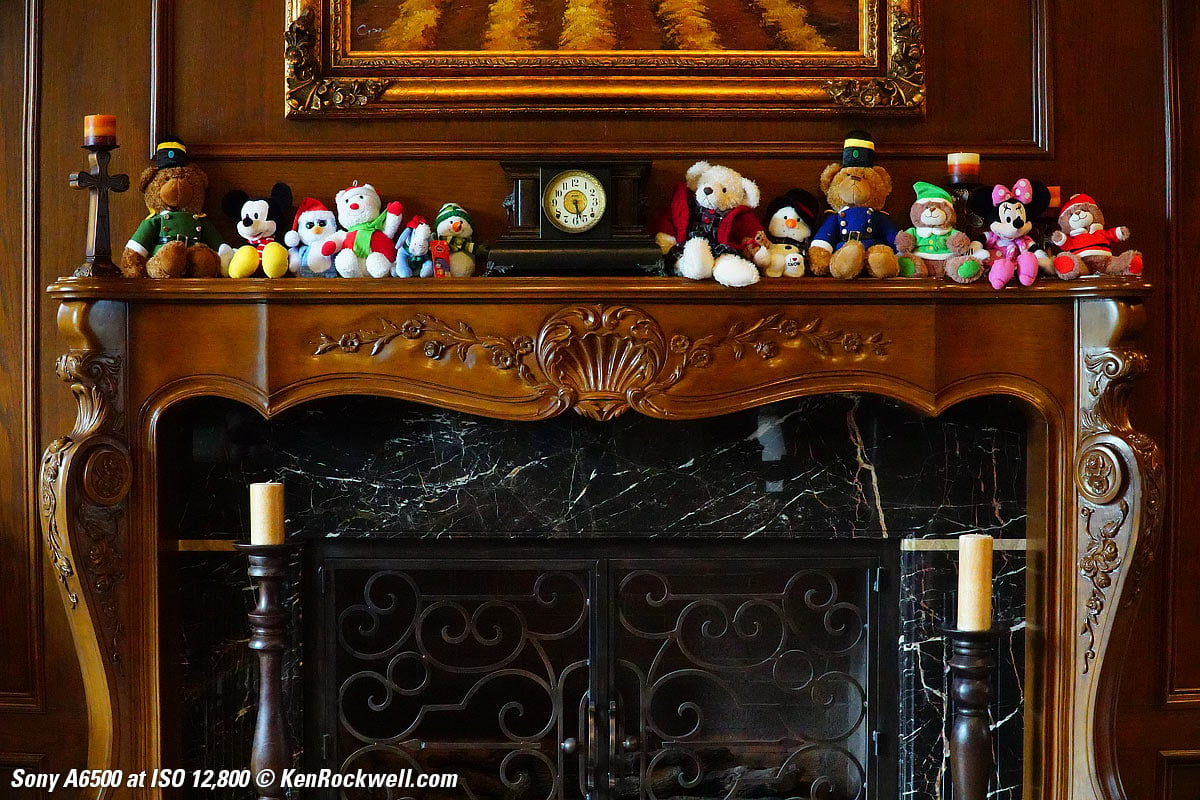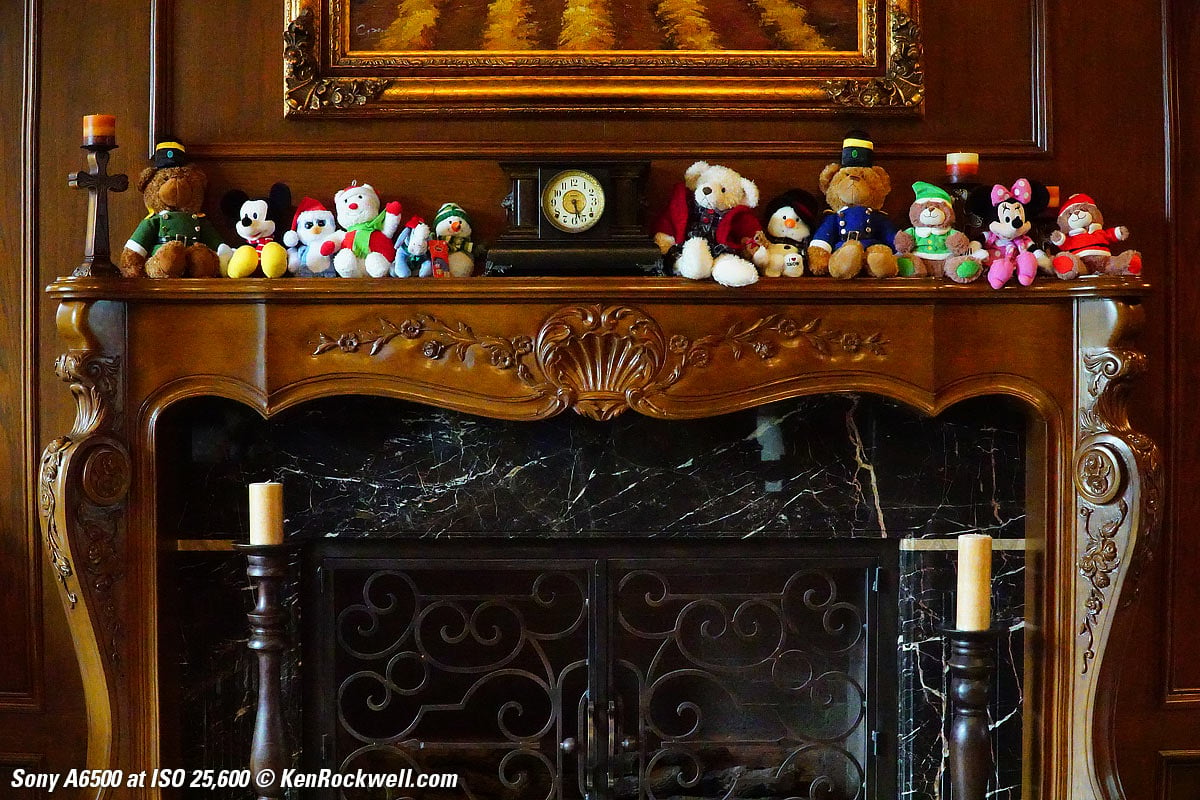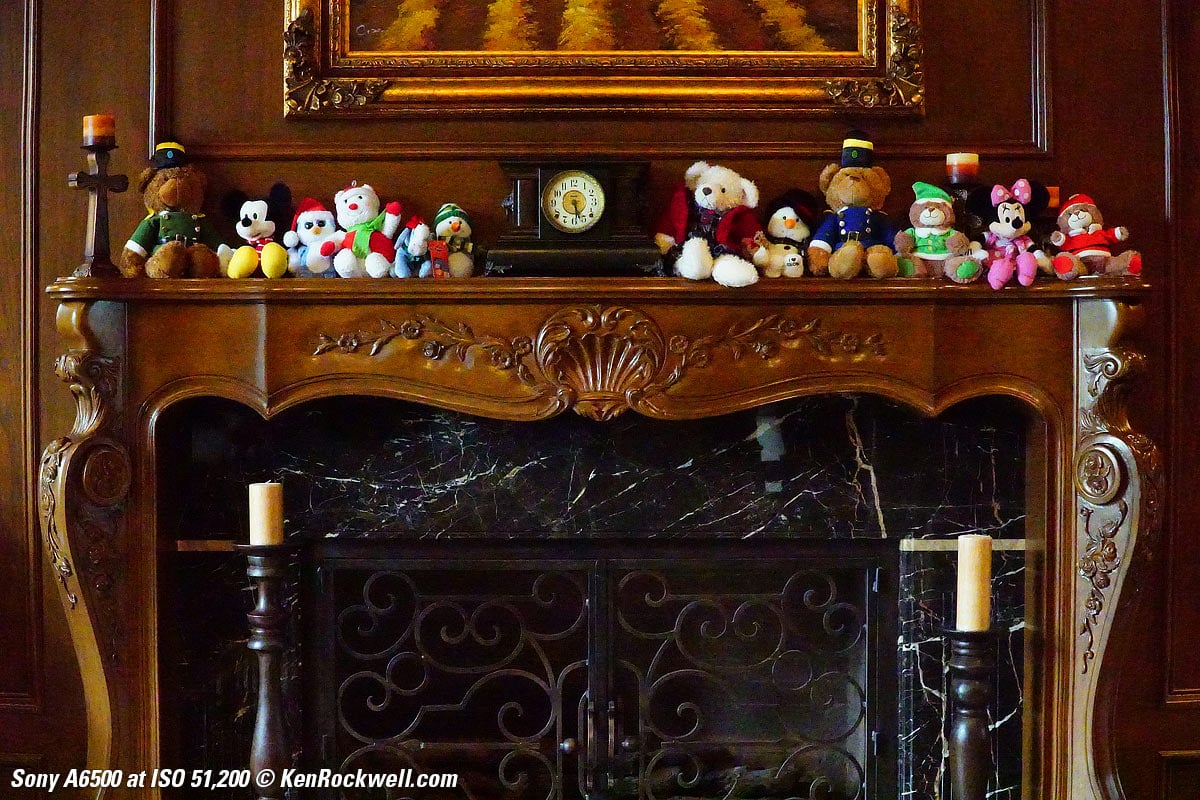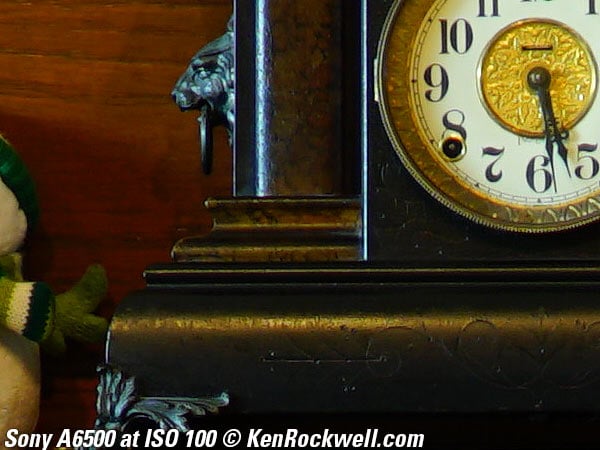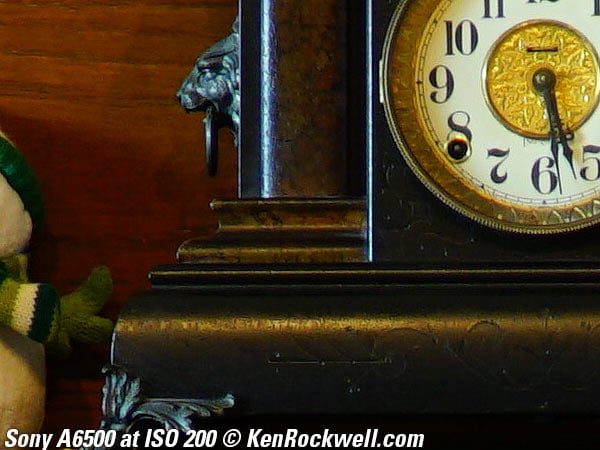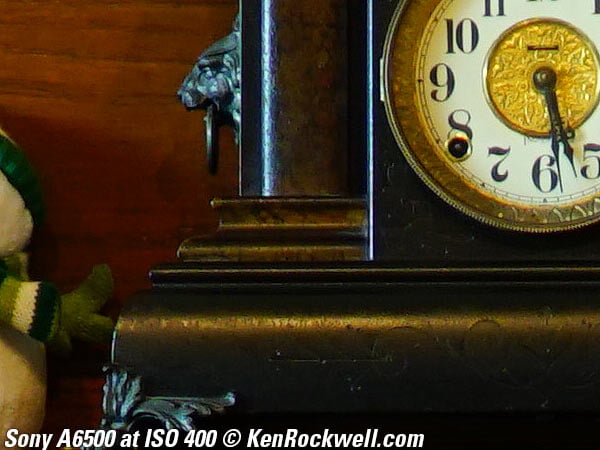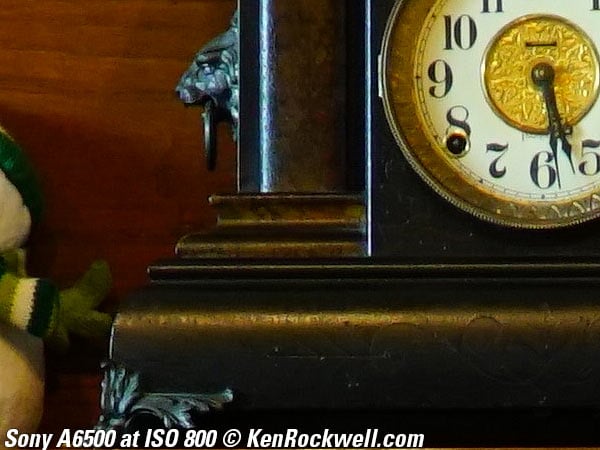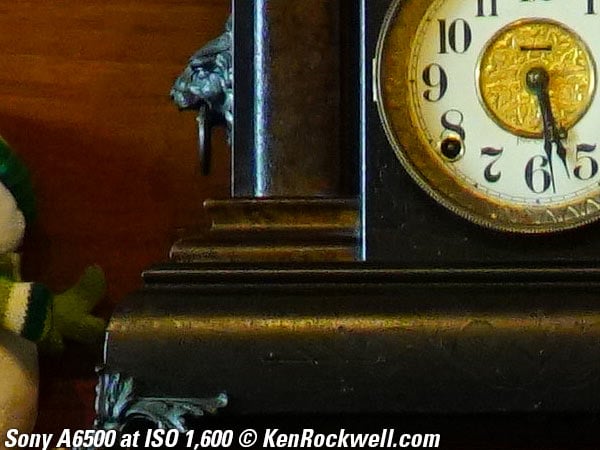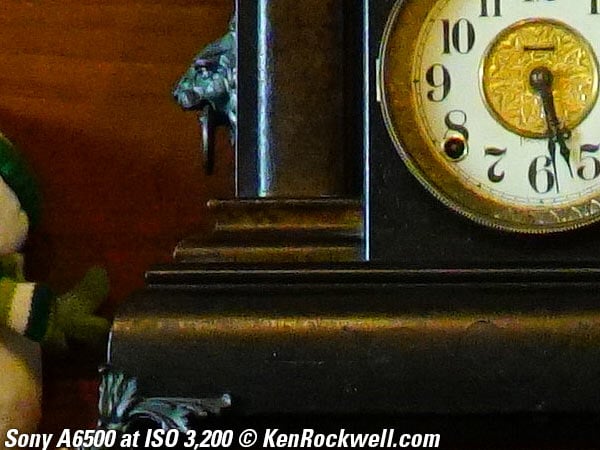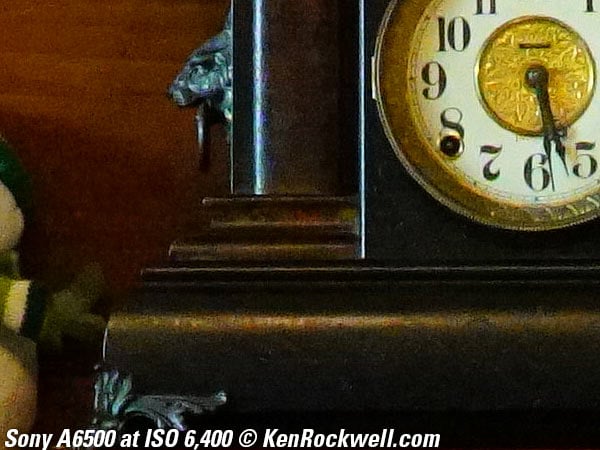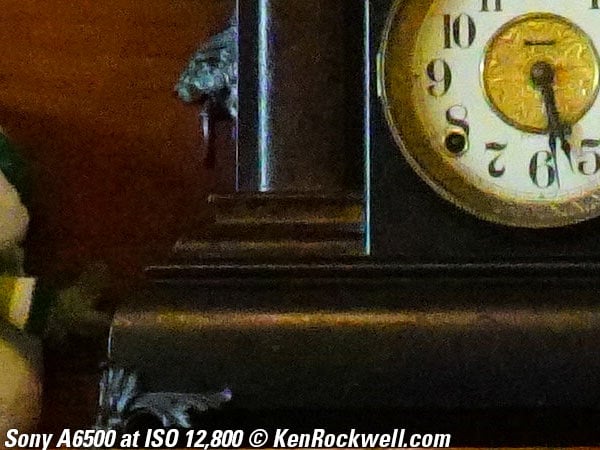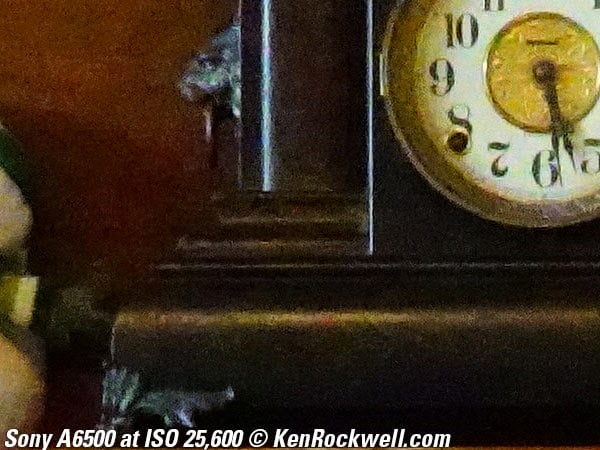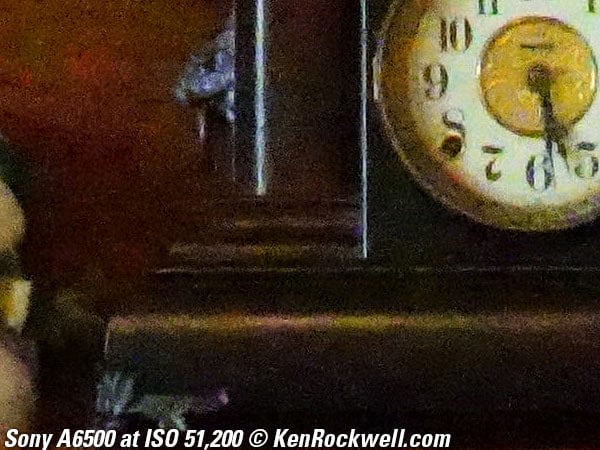Home Donate New Search Gallery Reviews How-To Books Links Workshops About Contact
Sony A6500
24MP APS-C, 11 FPS, 4K Stereo
Sample Images Intro Lenses & Adapters
Specs Legal USA Version Performance
Compared Usage Recommendations
Sony: A9 III A1 A9 II A9 A7R V A7R IV A7R III A7 IV A7 III A7R II A7S III A7c A7 II A6600 A6400 A6100 A6000 ZV-E10 RX10/4 RX100/7 RX100/6 Flash Lenses
Sony a6500 (15.8 oz./449g with battery and card, APS-C E-Mount, $798 new or about $675 used if you know How to Win at eBay) and PZ 18-105mm OSS. bigger. I got mine at Adorama. I'd also get it at Amazon or at B&H.
This all-content, junk-free website's biggest source of support is when you use those or any of these links to approved sources when you get anything, regardless of the country in which you live. Sony's boxes are not sealed in any way, so never buy at retail or any source not on my personally approved list since you'll have no way of knowing if you're missing accessories, getting a defective, store demo, damaged, returned or used product. My approved sources ship from remote automated warehouses where no salespeople or lookie-loos can ever get their sticky fingers on your new camera before you do. Buy only from the approved sources I use myself for the best prices, service, return policies and selection. Thanks for helping me help you! Ken.
February 2019 Sony Zeiss Minolta Nikon Canon Fuji LEICA All
Sony A6300 Review (2016 - )
Sony A6000 Review (2014 - )
Sony a6500. bigger.
Sony a6500. bigger.
Sample Images (more in the review, and loads more at my A6300 review which has exactly the same sensor) top
Sample Images Intro Lenses & Adapters
Specs Legal USA Version Performance
Compared Usage Recommendations
Christmas Lights, California, 10 December 2016. Sony A6500, Sony PZ 18-105mm OSS at 18mm, f/4 at 1/30 at Auto ISO 1,000, Perfectly Clear v2.) bigger or © full-resolution file to explore on your computer (mobile devices rarely display the full resolution accurately).
Christmas Lights, California, 10 December 2016. Sony A6500, Sony PZ 18-105mm OSS at 105mm, f/4 at 1/100 at Auto ISO 160, Perfectly Clear v2.) bigger or © camera-original file to explore on your computer (mobile devices rarely display the full resolution accurately).
Palm Trees, 13 December 2016. Sony A6500, Sony PZ 18-105mm OSS at 19mm, f/8 at 1/160 at Auto ISO 160, Perfectly Clear v2.) bigger or © camera-original file to explore on your computer (mobile devices rarely display the full resolution accurately).
Fan Sculpture, 17 December 2016. Sony A6500, Sony PZ 18-105mm OSS at 29mm, f/4 at 1/30 at Auto ISO 320, Perfectly Clear v2.) bigger or © camera-original file to explore on your computer (mobile devices rarely display the full resolution accurately).
Introduction top
Sample Images Intro Lenses & Adapters
Specs Legal USA Version Performance
Compared Usage Recommendations
|
I buy only from these approved sources. I can't vouch for ads below. |
The Sony A6500 is a superb APS-C mirrorless camera with an equally superb built-in electronic viewfinder (EVF).
This A6500 adds in-body stabilization and a primitive touch screen for an additional $400 over the otherwise mostly identical A6300.
The A6500 performs about as well as Sony's full-frame A7R II or A7S II cameras for half the price — and this A6500 is over twice as fast and has a built-in flash not in the other full-frame cameras!
The a6500 focuses super-fast and makes great-looking images in just about any light. The biggest reason to pay more for the A7R II or A7S II is if you need a dedicated exposure compensation dial — but you can assign the rear command dial to this in menus. The full-frame cameras are better if you really need ISOs above 25,600 (you don't) or need more than 24 megapixels, which you don't either.
The biggest difference between APS-C cameras and full-frame is that there's deeper depth-of-field on APS-C, while full-frame systems have shallower depths of field. They're all super-sharp and work great at high ISOs; if you prefer smaller size, weight, more in focus and higher frame rates get this A6500; go full-frame if you prefer shallower depth-of-field or want to use old 35mm lenses on adapters.
I refer to the A6500, a6500 and α6500 interchangeably; they're the same camera. Sony uses all three designations depending on where you read it.
I got my A6500 at Adorama. I'd also get it at Amazon or at B&H, or used at eBay if you know How to Win at eBay.
● In-body "5-axis" stabilization.
● New shutter "tested" to 200,000 cycles.
● Very basic touch-screen with limited functions; it's no iPhone.
● Bigger buffer: 300 JPG or 107 raw frames (versus 44/21 in A6300), but who cares; after about a dozen or so frames it's lost focus lock on moving targets anyway.
● Slightly reorganized and more colorful menu system.
● 1.545 oz. (43.8g) heavier than the A6300.
● $400 more expensive than the A6300.
● 10% shorter rated battery life than the A6300.
● Same 24MP sensor, same ISO range, same 11 FPS frame rate, same AF system, same viewfinder, same frame rate and same video performance as the A6300.
● Small, light, fast, tough and makes great-looking pictures.
● Built-in flash.
● Superb electronic viewfinder.
● Two Memory recall modes on the top dial.
● Pretty good ergonomics.
● Remote control via a phone app.
● WiFi & NFC.
● Completely silent in Silent mode.
● Slower handing than a DSLR; still need to wait a moment to turn-on, wake-up or change settings.
● Flash, Bulb mode and high frame rates don't work in Silent mode.
● LCD is too dim for daylight, too small to show pictures as well as any iPhone, and doesn't flip very far.
● No front control dial.
● No GPS.
● No "My Menu" menu.
● No exposure compensation dial (you can assign the rear dial to this, or you have to fiddle in a menu).
● No 1:1 square or 4:3 crop modes; only shoots native 3:2 or a silly 16:9 crop.
● No way to back up the complete camera state as Nikons can do.
● Programmable Memory recall modes don't recall everything, for instance, the memory modes don't save and recall whether or not you're in Silent mode.
● No second card slot.
● The LCD isn't bright enough to see in direct sunlight.
● No LCD auto brightness control — but the finder's auto brightness control is excellent.
● No headphone jack.
● No NTSC and no PAL video.
Lens Compatibility and Adapters top
Sample Images Intro Lenses & Adapters
Specs Legal USA Version Performance
Compared Usage Recommendations
I got my A6500 at Adorama. I'd also get it at Amazon or at B&H, or used at eBay if you know How to Win at eBay.
Lens Compatibility
Sony A6500. bigger.
The A6500 uses the Sony E-Mount, first seen on the NEX cameras. Sony sells its own lenses and Zeiss lenses that are native to this mount.
All full-frame FE and APS-C E-mount lenses work great.
Lens Adapters
Native Sony & Minolta Adapters
The Sony LA-EA4 adapter lets Sony Alpha and Minolta MAXXUM lenses work flawlessly, with super fast AF and 100% data and exposure automation compatibility.
While the Alpha and MAXXUM SLR lenses lack the optical quality of the latest Zeiss E and FE lenses, they do work very, very well.
Since this is an APS-C camera and those SLR lenses are full frame I'd not bother with this adapter, unless you have a pro-level tele zoom like the MAXXUM 80-200mm f/2.8 or a macro like the MAXXUM 50/2.8 or MAXXUM 100/2.8.
Other Brand Adapters
Sony A6500 and Nikon 55mm f/1.2 on an adapter. bigger.
The biggest gotcha with the Sony system is that there are very few native lenses for it, and most of Sony's and Minolta's lenses aren't that great; Zeiss, Canon and Nikon make better lenses.
While you can adapt any lens to the A6500, they won't work as well as native Sony or Zeiss FE lenses, or Alpha or MAXXUM lenses with the LA-EA4 adapter.
This great little camera becomes a clunky contraption once you add an adapter. The thing may or may not work that well, and probably won't give you anywhere near the resolution you thought you wanted unless you use the native Zeiss lenses.
Forget LEICA, Nikon or other old manual focus lenses; you'll have to open and close the diaphragm completely manually for each frame!
The best non-native solution is to use a decent Canon EOS to NEX adapter and you'll get full autofocus, auto exposure, EXIF data and diaphragm operation with every Canon lens made since 1987.
Better, with a Canon adapter you can use a real man's lens like the Canon 50mm f/1 for great results in starlight. The Canon 50mm f/1 doesn't cost much more than the NOCT-NIKKOR 58mm f/1.2, and it's decades ahead in speed and performance. The Nikon NOCT sells for what it does because collectors pay that much, while collectors haven't discovered the Canon 50mm f/1 which still sells for the same price it has for the past 25 years.
Specifications top
Sample Images Intro Lenses & Adapters
Specs Legal USA Version Performance
Compared Usage Recommendations
I got my A6500 at Adorama. I'd also get it at Amazon or at B&H, or used at eBay if you know How to Win at eBay.
Name
Sony calls this the ILCE-6500, ILCE6500, ILCE6500/B, A6500, a6500 and α6500 interchangeably.
Sensor
24 MP.
APS-C 15.6 x 23.5 mm.
1.534x crop factor.
6,000 x 4,000 pixels native.
1.5:1 aspect ratio.
Short 18mm flange focal distance allows better lens designs than DSLRs do — the same advantage rangefinder cameras have.
Claims 5-way mechanical sensor-shift image stabilization.
Image Sizes
6,000 x 4,000 (24 MP), 4,240 x 2,832 (12 MP) and 3,008 x 2,000 (6 MP)
Also 16:9 crops to 6,000 x 3,376, 4,240 x 2,400 and 3,008 x 1,688.
No Square Crop.
ISO
Manual ISO
ISO 100 ~ ISO 51,200.
Auto ISO
Auto ISO 100 ~ ISO 51,200.
Minimum shutter speed settable in full stops 30s ~ 1/4,000 — or — settable ±2 stops in one-stop increments to follow the lens focal length.
Color Spaces
sRGB and Adobe RGB.
Image Formats
JPG, 14-bit raw and JPG + raw.
Auto Focus
425 zones phase detection.
169 zones contrast detection.
Tracking & continuous AF.
Face and smile detection.
Frame Rates
11 FPS maximum, 300 frame JPG/107 frame raw buffer.
Three rate settings: Very High, High, Medium and Low.
Only the Low setting is available In Silent Mode. You need to be in the regular mechanical shutter mode for the fastest frame rates.
Shutter
When set, the electronic shutter of the Silent mode bypasses the focal plane shutter and is completely silent.
1/4,000 ~ 30 seconds.
Remote control via a phone app.
10, 5 or 2s self timer.
Flash Sync
1/160 sync speed.
Flash
Sony a6500 and pop-up flash. bigger.
Built-in flash; GN 20'/6m at ISO 100.
Hot shoe.
Video
16:9.
Longest take: 29m59s.
UltraHD 4K
XAVC S
3,840 x 2,160p / 30 fps (100 Mbps) / 30 fps (60 Mbps) / 25 fps (100 Mbps) / 25 fps (60 Mbps) / 24 fps (100 Mbps) / 24 fps (60 Mbps).
High Definition
XAVC S
1,920 x 1,080p / 120 fps (100 Mbps) / 120 fps (60 Mbps) / 100 fps (100 Mbps)/ 100 fps (100 Mbps) / 60 fps (50 Mbps) / 50 fps (50 Mbps)/ 30 fps (50 Mbps) / 25 fps (50 Mbps) / 24 fps (50 Mbps).
AVCHD
1,920 x 1,080p / 60 fps (28 Mbps) / 50 fps (28 Mbps) / 25 fps (24 Mbps)/ 25 fps (17 Mbps) / 24 fps (24 Mbps) / 24 fps (17 Mbps).
1,920 x 1,080i / 60 fps (24 Mbps) / 60 fps (17 Mbps) / 50 fps (24 Mbps)/ 50 fps (17 Mbps).
MP4
1,920 x 1,080p / 60 fps (28 Mbps) / 50 fps (28 Mbps) / 30 fps (16 Mbps)/ 25 fps (16 Mbps).
1,280 x 720p / 30 fps (6 Mbps) / 25 fps (6 Mbps).
NTSC & PAL
No NTSC and no PAL video.
Audio
Stereo Mic.
Mic input connector.
One mono speaker.
Finder
2,359,296 dot 0.39" OLED.
0.7x magnification.
-3 ~ +4 diopters.
23mm eyepoint.
Can run at 120 fps for fluidity.
LCD
Sony A6500. bigger.
Short 16:9 "chopped" 3" LCD.
Flips up and down, but doesn't swing left or right.
921,600 dots.
Black bars on the sides of the LCD leave only 2.6" (66mm) effective image diagonal for 3:2 images on the 16:9 LCD.
Storage
One SD slot for an SD, SDHC or SDXC card.
Can use a Memory Stick Pro Duo, Memory Stick PRO HG-Duo, or 3.5" floppy disk in the SD slot. (Just kidding about the floppy.)
Connections
Sony a6500 connectors. bigger.
Micro USB 2.0
Micro HDMI-D.
3.5mm Mic input.
WiFi & NFC.
Power & Battery
Rated 310 shots with viewfinder or 350 shots with rear LCD.
Charges via USB in-camera.
NP-FW50 battery included: 1,080 mAh 7.2V.
Sony NP-FW50 battery. bigger.
Sony A6500 battery & card compartment. bigger.
Size
4.7 x 2.6 x 2.1 inches, excluding protrusions.
120.0 x 66.9 x 53.3 millimeters, excluding protrusions.
Weight
15.830 oz. (448.8g) actual measured weight with battery and card.
Rated 16.0 oz. (453g) with battery and card.
Quality
Sony A6500. bigger.
Made in Thailand.
Environment
0 ~ 40º C (32 ~ 104º F).
Introduced
06 October 2016.
Included
A6500 camera.
Strap.
NP-FW50 battery.
USB cord and universal wall USB power supply.
Price
December 2019
$798 new, or about $675 used if you know How to Win at eBay.
February 2019: $1,098.
October~ December 2016: $1,398.
Sony A6500 box. bigger.
Legal USA Version (applies in USA only) top
Sample Images Intro Lenses & Adapters
Specs Legal USA Version Performance
Compared Usage Recommendations
So long as you get yours from an authorized source, you'll get a legitimate USA version with a warranty from Sony USA.
I got my A6500 at Adorama. I'd also get it at Amazon or at B&H, or used at eBay if you know How to Win at eBay.
USA cameras will say "UC2" on the UPC label on the box:
Sony A6500 box. Note "UC2" on white UPC sticker. bigger.
In your unsealed box you will get an English and a French manual, a solicitation for a credit card, and most importantly a warranty paper which specifically mentions the USA and has Sony's USA phone number:
Sony's USA paperwork. bigger.
If you do something stupid like buy from a source that is not an approved source, you may get a gray market version, which has no warranty in the USA and will not have this card.
Buying gray market is always taking a chance compared to getting a legal USA version. If you can save $500, go for it, but if you only get $100 off, I wouldn't risk it.
Performance top
Sample Images Intro Lenses & Adapters
Specs Legal USA Version Performance
Compared Usage Recommendations
Overall Autofocus Finder Shutter
Frame Rates Silent Mode Ergonomics
Sharpness Color Rendition Auto ISO
I got my A6500 at Adorama. I'd also get it at Amazon or at B&H, or used at eBay if you know How to Win at eBay.
The A6500 is a great little camera.
I love its EVF, speed, tiny size, tough build and great looking pictures in any light — as well as its completely silent operation.
It just shoots and shoots and shoots in any light.
Autofocus is great: it's fast and accurate.
Face recognition really works. It finds and focuses on faces with no need to select them manually. It puts a green box around them and tracks them all over — but only if you activate this feature in the menu system! (MENU > CAMERA 1 > page 14/14 > Smile/Face Detect > Face Detection On.)
It's ultrafast, but on rare occasions can miss perfect focus. It's nowhere near as good as a DSLR for tracking action. It usually tracks the beginning of a sequence, but then loses focus halfway through. For sports, get a DSLR.
It works swell in the dark outside at night and doesn't need its AF illuminator, hallelujah!
The EVF is superb.
It's sharp, bright and colorful and works flawlessly in anything from daylight to moonlight. Sony makes the best EVF there is.
It stays in focus because the finder focus wheel is where it doesn't get knocked.
The optics are OK, but still a little swimmy in spots due to the diopter adjustment optics. I prefer good old-fashioned fixed eyepieces over diopter adjustment wheels.
Shutter
In its regular mode, the mechanical shutter only moves at the end of an exposure. Even though you hear what sounds like a shutter firing, you'll notice at slow speeds that there is no sound at the beginning of the exposure, only the end.
This is magnificent, because it means that there will be no vibration from the shutter to blur handheld images.
In silent mode, the mechanical shutter doesn't move at all.
Frame Rates
My A6500 actually motors along at 11 frames per second in its HI+ mode, which is superb — but only for for targets that don't move since it locks focus and exposure.
For moving targets, you have to select the regular (slower) HI mode, which lets it focus, and also slows it down.
It only runs this fast in the usual shutter mode; in Silent mode it only runs at the slowest LO mode.
I LOVE the Silent mode. Set in the menu system (MENU > CAMERA 2 > page 4/9 > Silent Shooting), it makes the a6500 completely silent. I can shoot anything and anyone and anyplace, and people presume I haven't taken any pictures!
There is no Bulb setting in the Silent mode; you have to know to disable Silent mode to make the Bulb option appear in the Manual mode.
Only the LO option works in the continuous shutter mode, the faster MID, HI and HI+ modes are disabled in Silent mode.
Ditto for flash; you have to know to disable the Silent mode to let the flash fire.
While Sony's menu system is pretty bad, the position of the buttons and knobs is excellent.
Noteworthy is that the MENU button is on the right side, so now ALL the camera's functions are available while shooting with one hand.
Once you get the camera set it works very fast, but getting it set can be maddening since important menu options are carelessly spread all over its arbitrary menu system. Expect to wade through the entire system every time you want to find something. It takes a long time to learn this camera.
All the buttons are flush and feel the same, so good luck finding them by feel.
Unlike a DSLR, it always takes a moment to wake up and be ready to shoot. The A6500 locks-up for a second or so whenever you change the mode dial between its two memory 1 and 2 settings.
Silent mode is not saved in memory, so its several menu operations to get out of it to be able to use the flash or bulb mode.
It's super sharp.
With 24 Megapixels, you have about 20 megapixels more than you really need for anything. If you can't get a sharp photo, it's because you're doing something stupid, like shooting at f/32, aren't in focus, something moved or you're using an old lens on an adapter instead of a Zeiss lens.
Color Rendition
Sony keeps getting better and better at color rendition, and the A6500 is their best yet.
While it's still not quite up to the level of Nikon or Canon for serious work, the A6500 looks great for the fun shots people make with mirrorless cameras. For my vacations, it looks wonderful!
Color rendition is how pictures look in the real world. Real-world color rendition has nothing to do with color accuracy measured in a lab. Color rendition is dependant on how a maker programs all the color matrices, curves, and look-up tables to generate color from the data read from the sensor, and varies widely between makers once you set a camera away from its defaults. I never shoot at defaults.
I set it to VIVID and +3 Saturation (see Usage), and get results as seen at Sample Images and below. It usually looks good, but I get more consistently excellent results from Nikon and Canon.
For people pictures I set it to Standard and +1 saturation (see Usage) and get quite pleasant results.
I use my images right out of the A6500. If you shoot raw and complete the processing later in software, your results will depend heavily on your choice of software and how you use it. I'm looking at how the A6500 processes my images.
Yes, I get good colors right out of the A6500, but they aren't as great as I get more consistently out of my DSLRs.
I'm a working artist, not some online tweaker or tech blogger, and color is critical to my work. I'm pickier about color than most; I see things most people don't. I can get photos that get oohs and ahhs with my A6500, but I don't get to WOW! as often with my A6500 as I do with my Nikon and Canon DSLRs.
Auto ISO is superb, letting us set the minimum and maximum ISO as well as the minimum shutter speed, and the A6500 does the rest by itself.
It's smart enough to let us have the camera choose the minimum shutter speed based on focal length, and lets us set an automatic offset two stops up or down from there. Bravo!
You also may select any speed from 30 seconds to 1/4,000 in full stops as the slowest shutter speed for Auto ISO.
It cheerfully runs up to whatever insane high ISO you've programmed it to go if it needs to, so you really can use all of the great high ISO performance of this camera.
High ISOs look great. They look as good as they can, and the Auto ISO system lets you use them automatically in any light without having to change any settings for each photo.
The A6500 looks great at just about any ISO; use whatever ISO you need to get a sharp picture.
I let my Auto ISO run all the way up to ISO 51,200.
Complete Images
Click any for the camera-original © files to explore on your computer; mobile devices rarely show the full resolution files properly.
The images all look about the same as web sizes up to about ISO 25,600 or even ISO 51,600; the highlights, shadows and colors match very well across the entire ISO spectrum with just a little extra rattiness at the very highest five-digit ISOs. Some years ago this wasn't the case; higher ISOs on older cameras would look quite different from lower ISOs even at small print sizes.
As you can see, pretty much any ISO you need will work well for reasonably sized web or print images. Blotchiness is normal at the highest ISOs; the camera is doing everything it can to make a picture out of essentially no light and no exposure.
Crops from above
These are 600 x 450 pixel crops from the original images. They will vary in size to fit your browser window; if they are about 6" (15cm) wide on your screen, the complete image would print at 40 x 60" (1 x 1.5 meters) at this same high magnification.
While images at high ISOs look great at reasonable print sizes, the differences are much more obvious at the high magnification shown below; we lose details and subtle textures at higher ISOs. As ISO climbs, we lose grain in the wood, the sparkles in the black wood grain, and everything gets softer. Fireplace bricks inside the grille disappear first on the left then the right, and the dust on grill vanishes.
Click any for the same camera-original © files as above to explore on your computer (mobile devices rarely show the full resolution files properly):
The electronic viewfinder is superb, but the rear LCD isn't very good. It's too small and too dim, and it doesn't swivel very far.
The LCD isn't bright enough to see in direct sunlight.
It uses a 16:9-shaped short or "chopped" LCD, so the image never fills the screen; it either has black on either side, or crops off part of the image if zoomed. It's too short for its width.
Because it's a 16:9 LCD and the sides are black when showing pictures, its effective diagonal is only 2.6" (66mm).
There's no way to read the file number.
It flips up and down a bit, but not left or right, and it doesn't flip far enough for self-portraits. It flips only enough to help you shoot from high or low angles.
The A6500 is about half metal and half plastic.
The top & bottom plates, lens mount, front & rear covers and the top all-black dial are metal.
All the smaller bits are plastic, like the power switch, shutter button, rear controls, flash, hatches, battery cover, LCD monitor and viewfinder frames and the top mode dial.
Cards are not properly formatted, they are left as "NO NAME" instead of "SONY_A65."
It takes too long to format a card; about 8 seconds for a 4GB card.
It's easy to set the first three characters of the file name; I use A65.
Its reasonably easy to program it to add copyright EXIF data to each file as you shoot.
Sony litters our cards with too many folders and hides videos in a different folder than our pictures.
Auto ISO reads properly in Media Pro up through ISO 32,000. ISO 40,000 reads ISO-25536 and ISO 51,200 reads ISO-14336.
It has a battery percentage indicator, but no long-term battery health indication.
The A6500 charges via USB only.
Compared top
Sample Images Intro Lenses & Adapters
Specs Legal USA Version Performance
Compared Usage Recommendations
I got my A6500 at Adorama. I'd also get it at Amazon or at B&H, or used at eBay if you know How to Win at eBay.
See also All Sony Cameras Compared.
Versus the A6300
As I covered at the top, the A6300 is 95% the same camera, without in-camera stabilization. If you need an in-camera stabilizer or any of the other few little features, great, but otherwise I'd save the $400 and get the A6300 instead.
Especially if you use lenses with their own stabilizers (OSS), I see no benefit to the in-camera stabilizer, and I haven't seen very good performance with in-camera stabilizers and unstabilized lenses.
Versus the A6000
The A6000 is 93% the same camera as the A6500, minus some little features I find critical, like two programmable memory modes on the top dial and fully programmable Auto ISO.
If you use these features as I do get the A6300 or this A6500; otherwise the A6000 is the same camera for less than one-third the price of this A6500!
Versus a DSLR
Get this A6500 for your vacations, or if size and weight are more important than price or performance.
Get a DSLR like a Nikon or Canon for serious shooting, or to save money.
Nikon and Canon DSLRs take better pictures, at least if you're as critical about color rendition as I am. They also handle faster, have much better battery life, and cost less for the same features!
By the time you spend as much as an a6500 for a DSLR, you're getting a very fancy DSLR. A basic DSLR like the Nikon D3300 or Canon SL1 costs only one-third as much as this A6500, and takes pictures at least as good. Basic DSLRs are also not much bigger or heavier than the A6500.
The A6500 is the girl you date for fun and good times until you find something better, while a DSLR is the woman you marry for a lifetime of serious pursuits. The A6500 is easy and fun, while a DSLR makes better pictures if you're serious beyond just posting on Facebook to be forgotten in a day.
I shoot my DSLRs every day for serious work. When I go on vacation, I'm pooped and leave my pro cameras at home and take an A6500. Its colors aren't as good, but if I'm tired of carrying cameras, the A6500 is the ticket. I jam it in a sock and throw it in my carry-on bag, and I'm good.
Versus Fujifilm
Sony and Fuji are completely different from each other:
Ergonomics
Fuji's cameras are designed by and for real photographers. Fuji cameras have far superior ergonomics, with real shutter, aperture, exposure compensation and other dials.
Sony's cameras have the world's worst menu systems, and then they force you to into menus and screens to set the most basic things like ISO and shutter speeds — but Fuji's menus aren't much better.
Quality
Fuji, like Canon, makes almost all of its cameras and lenses domestically in Japan.
Sony usually offshores its cameras — even the $3,200 made-in-Thailand A7R II — to whatever country can do it the cheapest.
Picture Quality
Fuji's cameras and sensors are strongly optimized for people pictures. For skin tones, Fuji is unbeaten. Fuji cameras make people look great in any light.
Unfortunately this strong optimization for skin tones makes the Fujis very bland to downright ugly for nature, landscape, architecture, and just about every other kind of photography. Except for people pictures, I much prefer the look I get from Sony cameras.
If you shoot raw or otherwise fiddle with everything in your computer that's one thing, but if you demand saleable JPGs right out of your camera as I do, Fuji wins for people, and Sony wins for everything else.
Shot as JPGs direct from the camera, I can't get the wild, vivid colors I demand for pictures of places and things that I can get right out of the Sony set to Vivid and +3 saturation. Fujis are simply too desaturated and too low-contrast — but for people pictures, Fujis rock.
Usage top
Sample Images Intro Lenses & Adapters
Specs Legal USA Version Performance
Compared Usage Recommendations
I got my A6500 at Adorama. I'd also get it at Amazon or at B&H, or used at eBay if you know How to Win at eBay.
See my Sony D6500 User's Guide.
Recommendations top
Sample Images Intro Lenses & Adapters
Specs Legal USA Version Performance
Compared Usage Recommendations
The A6500 is a fun and fast camera that produces very good results. It doesn't replace my Nikons, Canons or Hasselblads for serious work, but for carrying as little as possible, the A6500 is a hoot.
The A6500 is a premium camera; you pay extra for all the features and tiny size. A Nikon D3300 or Canon SL1 costs one-third as much, doesn't weigh much more and works faster and takes better pictures. If you can afford it, great, but if not, inexpensive DSLRs cost less and can take even better pictures due to better color rendition and generally better lenses.
The A6500 is a fantastic little camera. If you think you want one, get one — but be sure you can get the lenses you want for it. Unlike Nikon and Canon DSLRs, there are relatively few lenses for the Sony.
Personally I love the tiny, automatic collapsing PZ 16-50mm OSS lens. The whole point of this camera is small size, and the 16-50 does this in spades. The Zeiss 16-70mm is superb and also highly recommended, but it adds to the weight. The Sony 18-105mm is an even bigger lens, but covers the broadest range. I like to carry this camera around my shoulder under a jacket, and a big lens won't let me do that as well as the self-collapsing 16-50.
Be sure to use the a6500 only with Sony or Zeiss lenses made for E-Mount. Performance won't be as impressive with adapted lenses, and takes most of the speed and fun out of it. Adapted manual lenses are foolish; they slow down the operation so far that you may as well be shooting film for the same amount of effort.
See also Is It Worth It to figure out of the A6500 is worth it — to you.
I got my A6500 at Adorama. I'd also get it at Amazon or at B&H, or used at eBay if you know How to Win at eBay.
Unlike a bottle of milk or a roll of toilet paper, Sony doesn't seal its boxes in any way, so you have no idea if you're getting a used, returned, incomplete or damaged product if you risk buying at retail. Never buy at retail. Use only my personally approved sources for the best prices, service, return policies and selection— and they ship from secure remote warehouses where no customers or salesmen can get their sticky hands on your new camera before you do.
Thanks for helping me help you!
Ken.
© Ken Rockwell. All rights reserved. Tous droits réservés. Alle Rechte vorbehalten.
Help me help you top
I support my growing family through this website, as crazy as it might seem.
The biggest help is when you use any of these links to approved sources when you get anything, regardless of the country in which you live. It costs you nothing, and is this site's, and thus my family's, biggest source of support. These places have the best prices and service, which is why I've used them since before this website existed. I recommend them all personally.
If you find this page as helpful as a book you might have had to buy or a workshop you may have had to take, feel free to help me continue helping everyone.
If you've gotten your gear through one of my links or helped otherwise, you're family. It's great people like you who allow me to keep adding to this site full-time. Thanks!
If you haven't helped yet, please do, and consider helping me with a gift of $5.00.
As this page is copyrighted and formally registered, it is unlawful to make copies, especially in the form of printouts for personal use. If you wish to make a printout for personal use, you are granted one-time permission only if you PayPal me $5.00 per printout or part thereof. Thank you!
Thanks for reading!
Mr. & Mrs. Ken Rockwell, Ryan and Katie.
Home Donate New Search Gallery Reviews How-To Books Links Workshops About Contact
